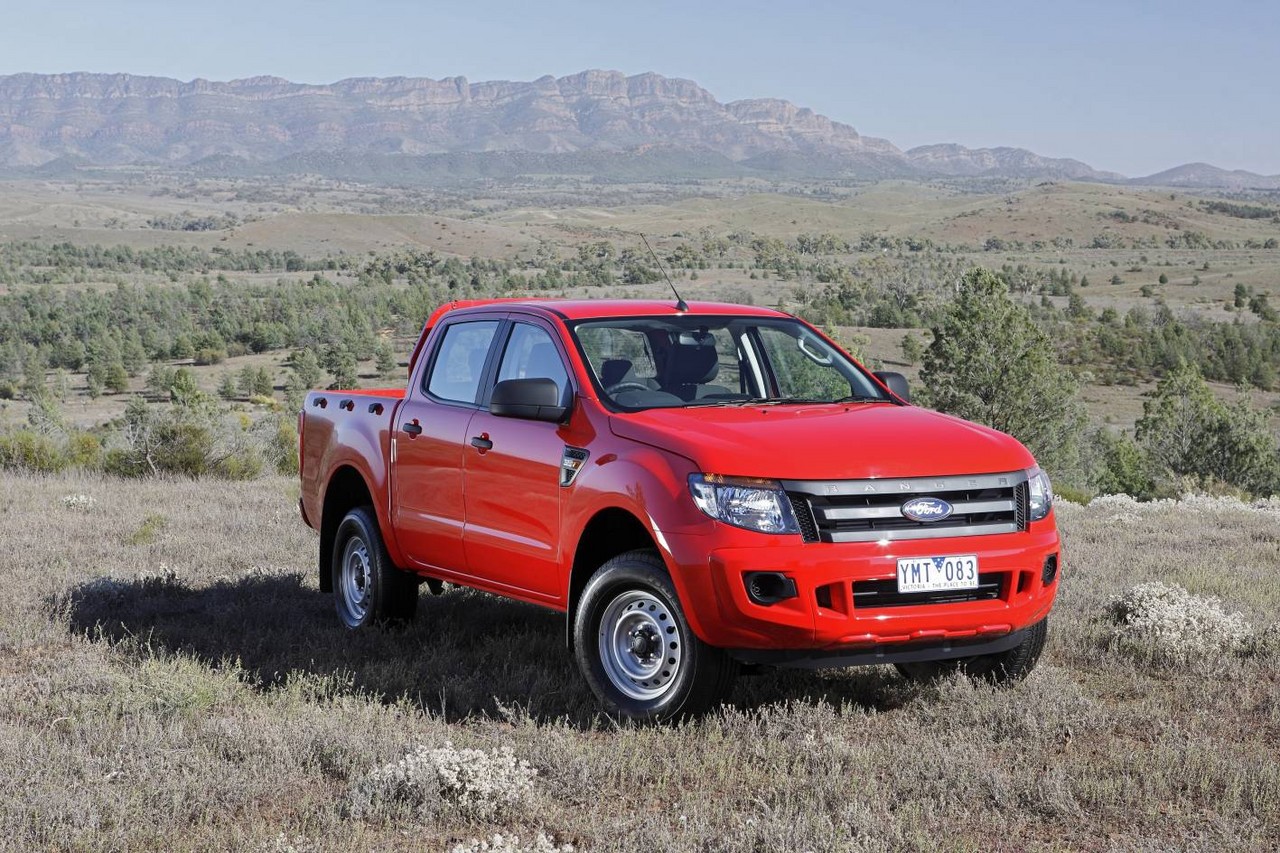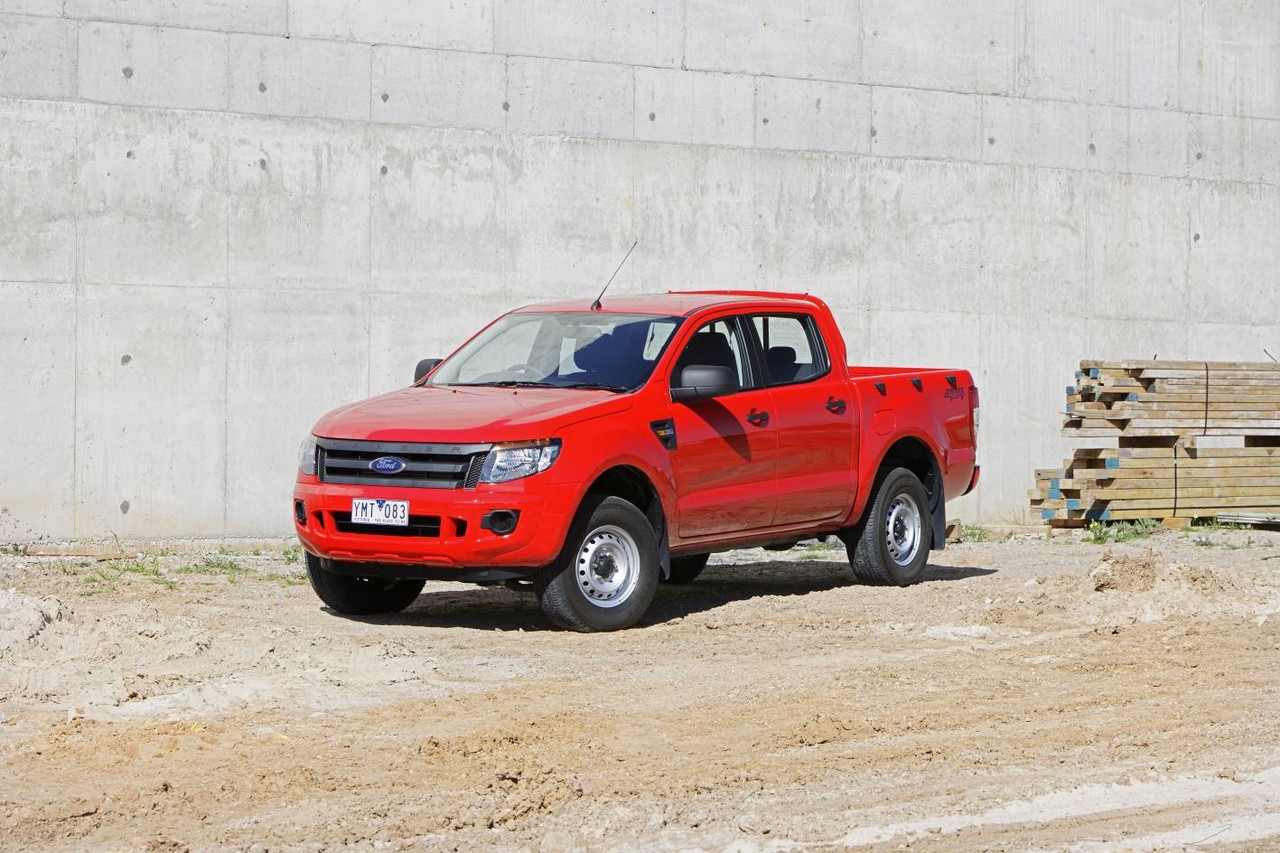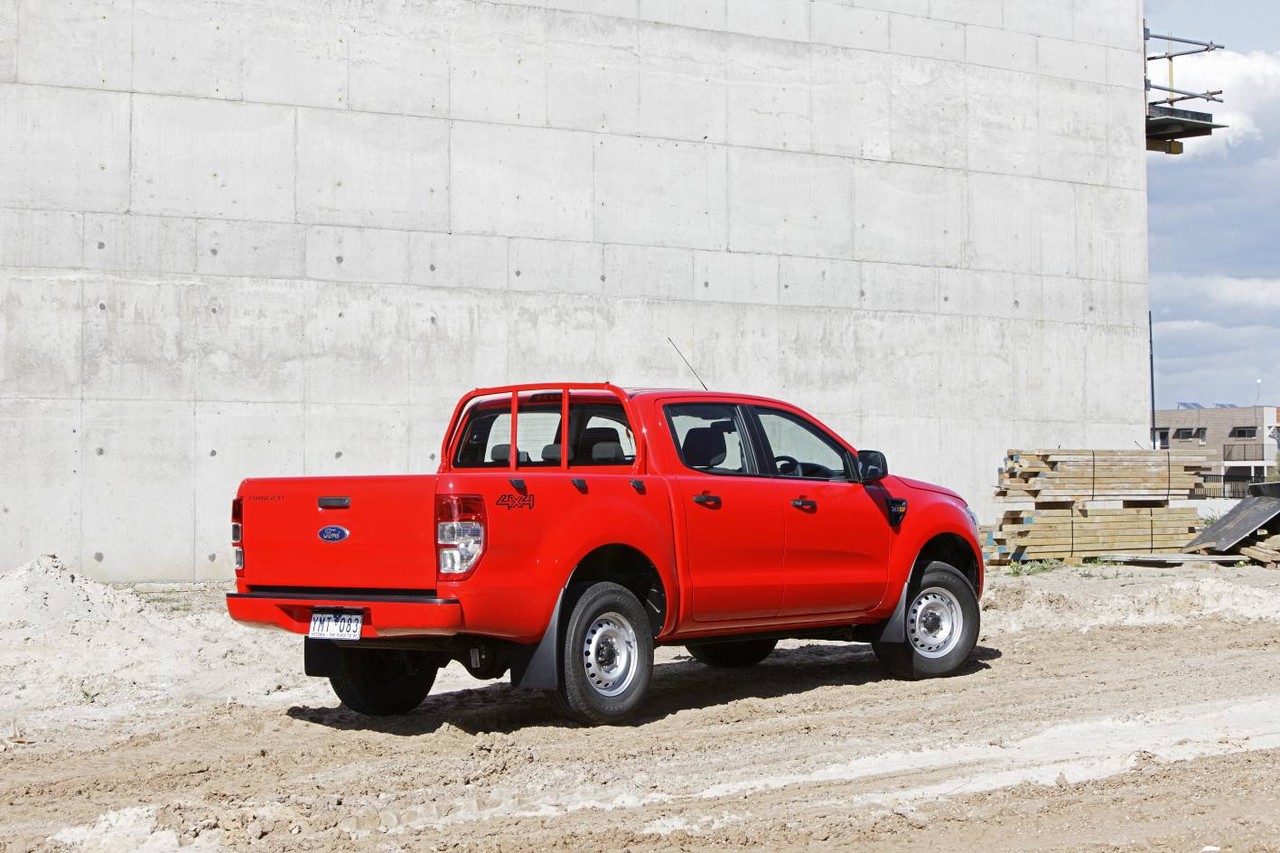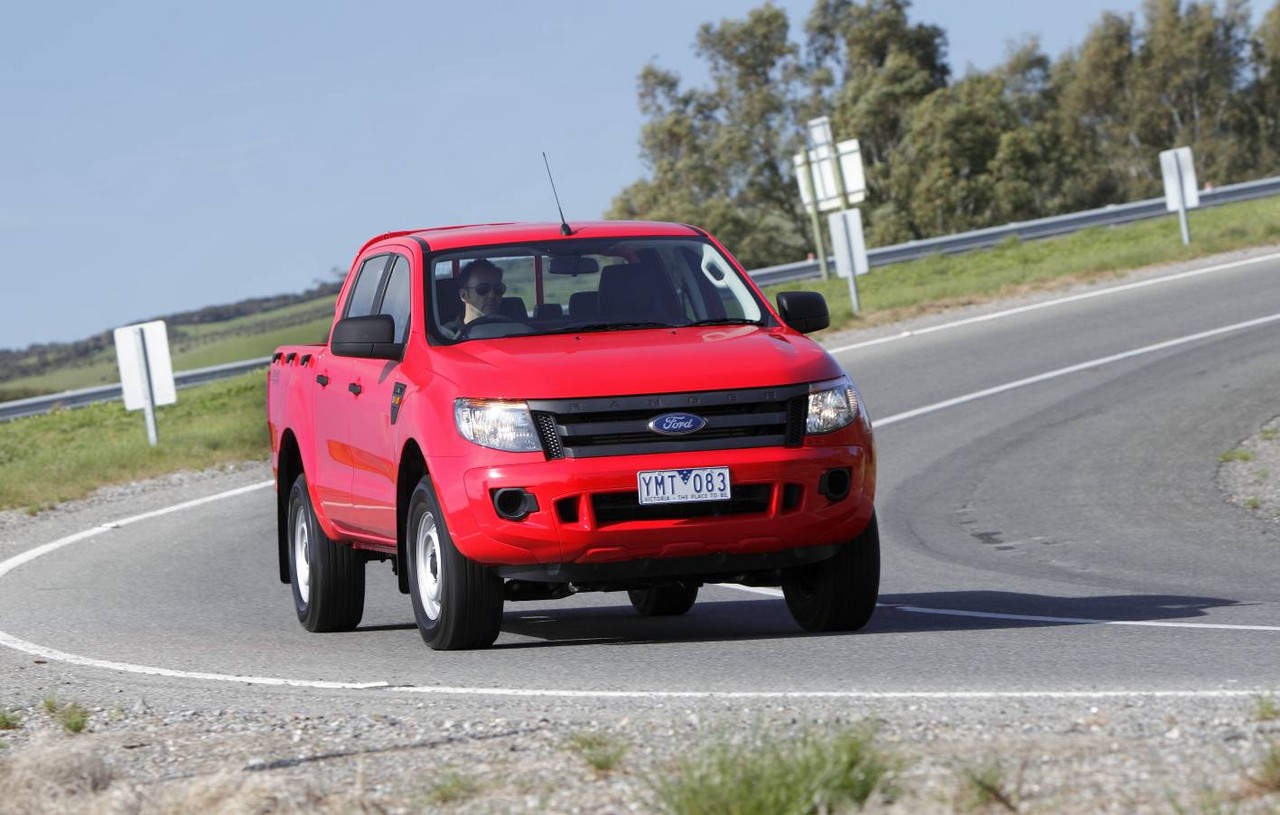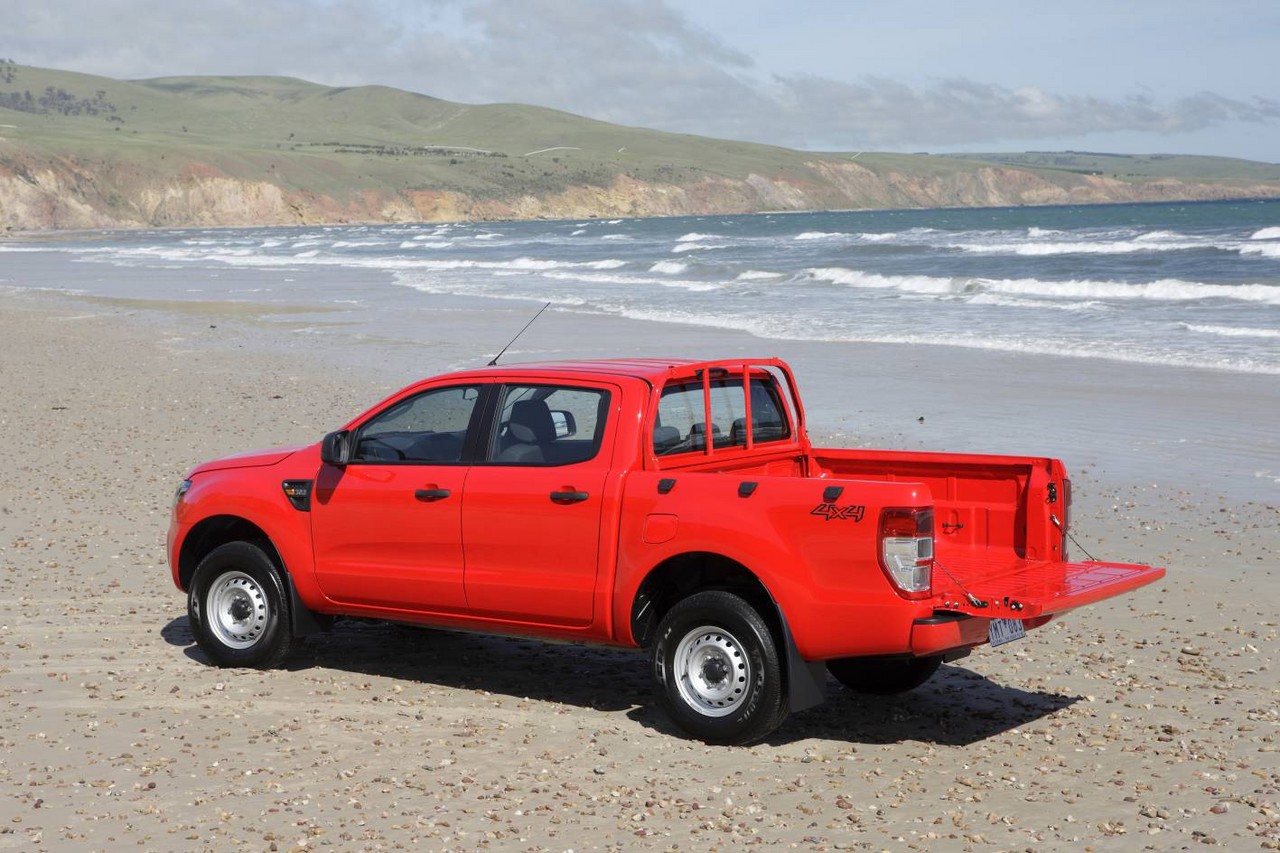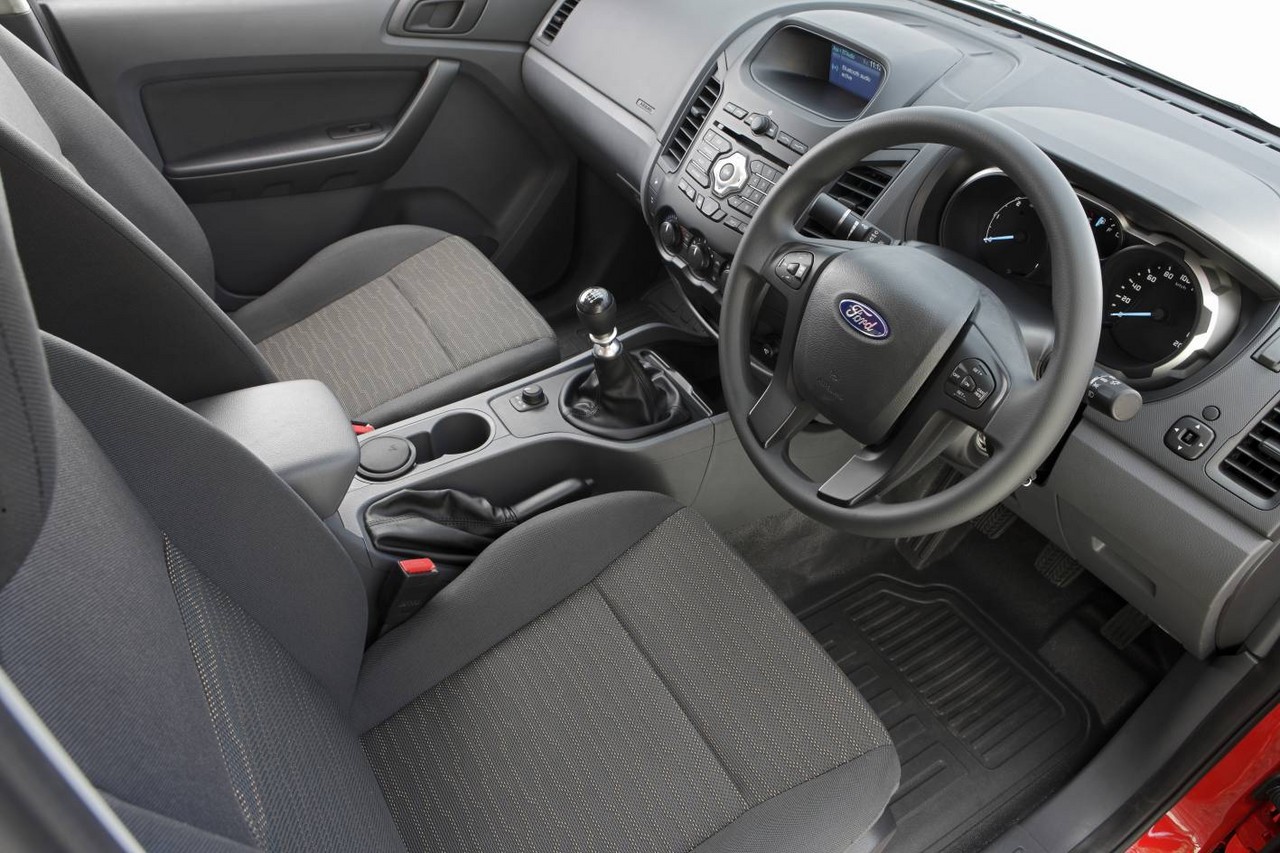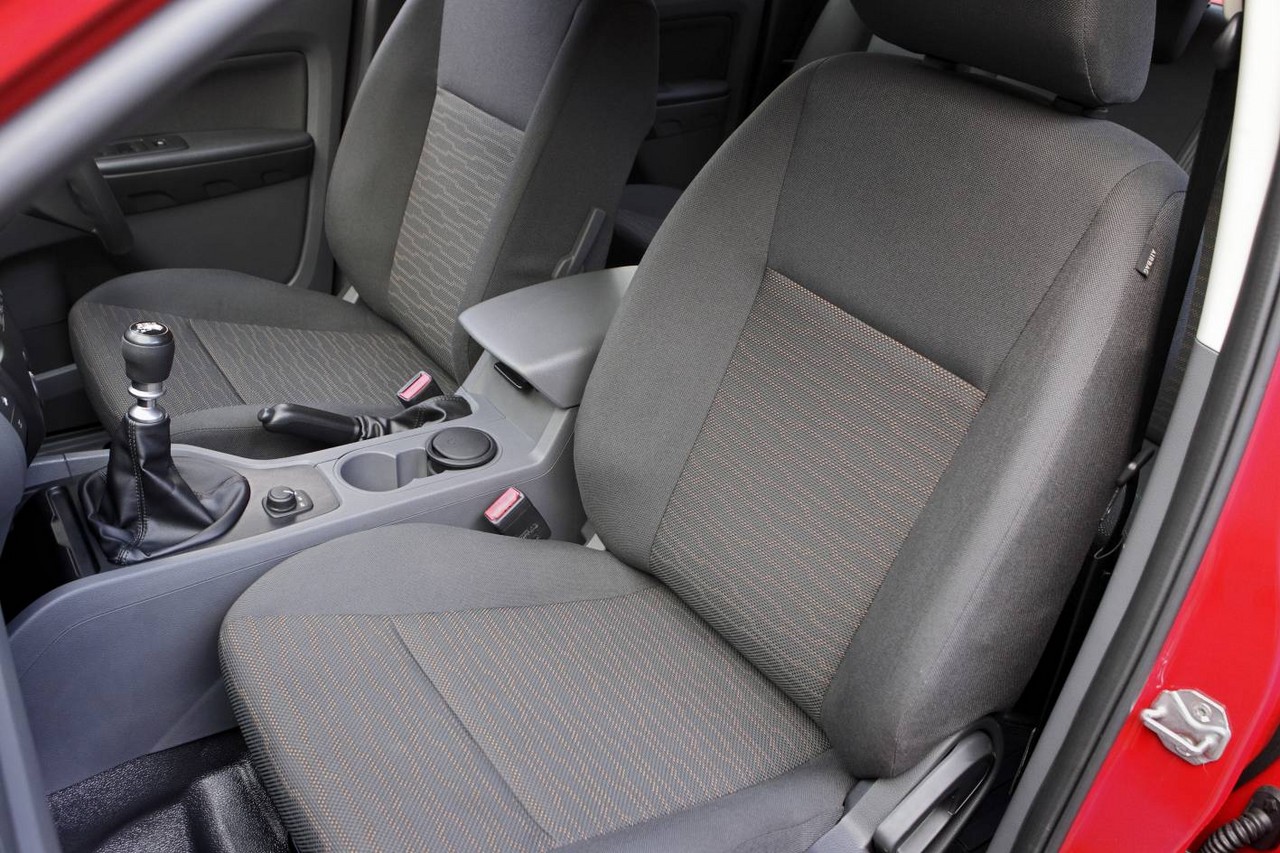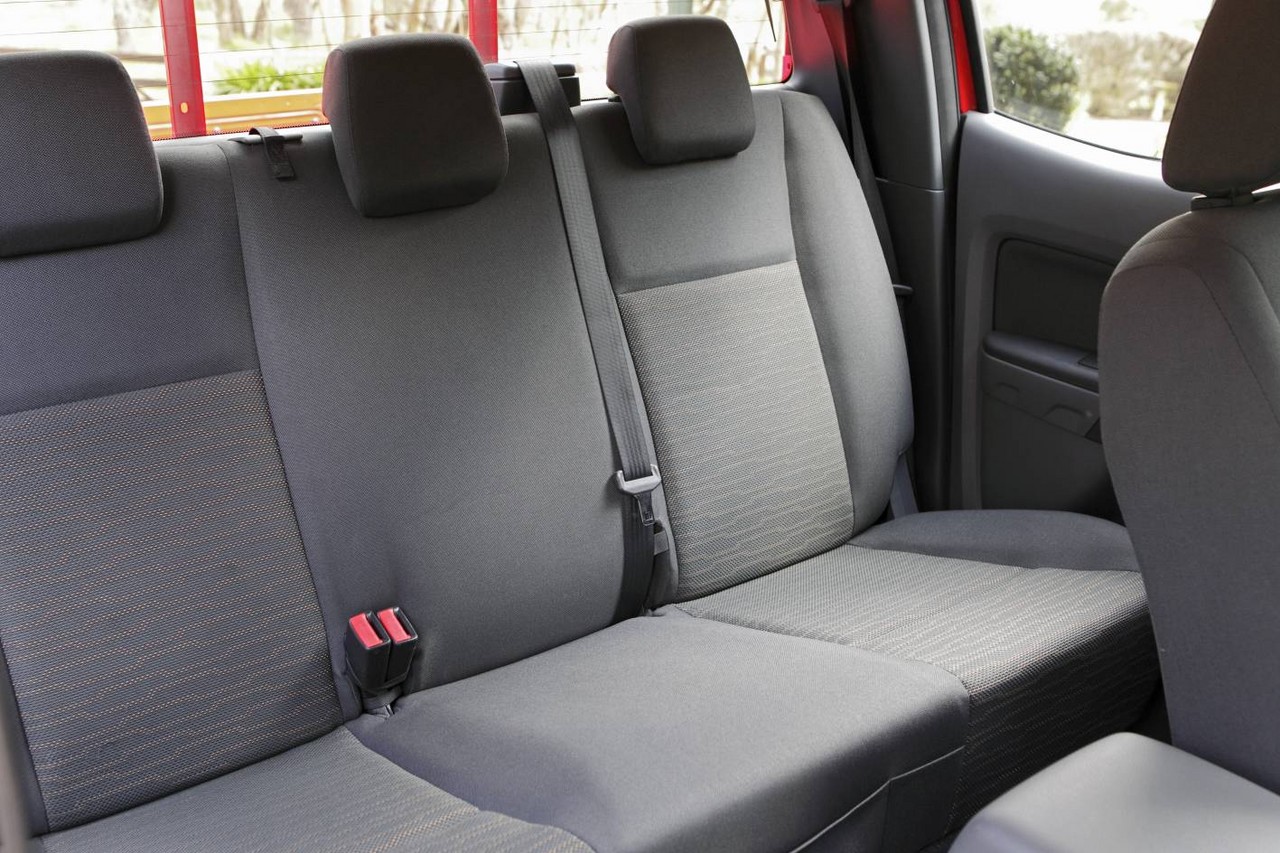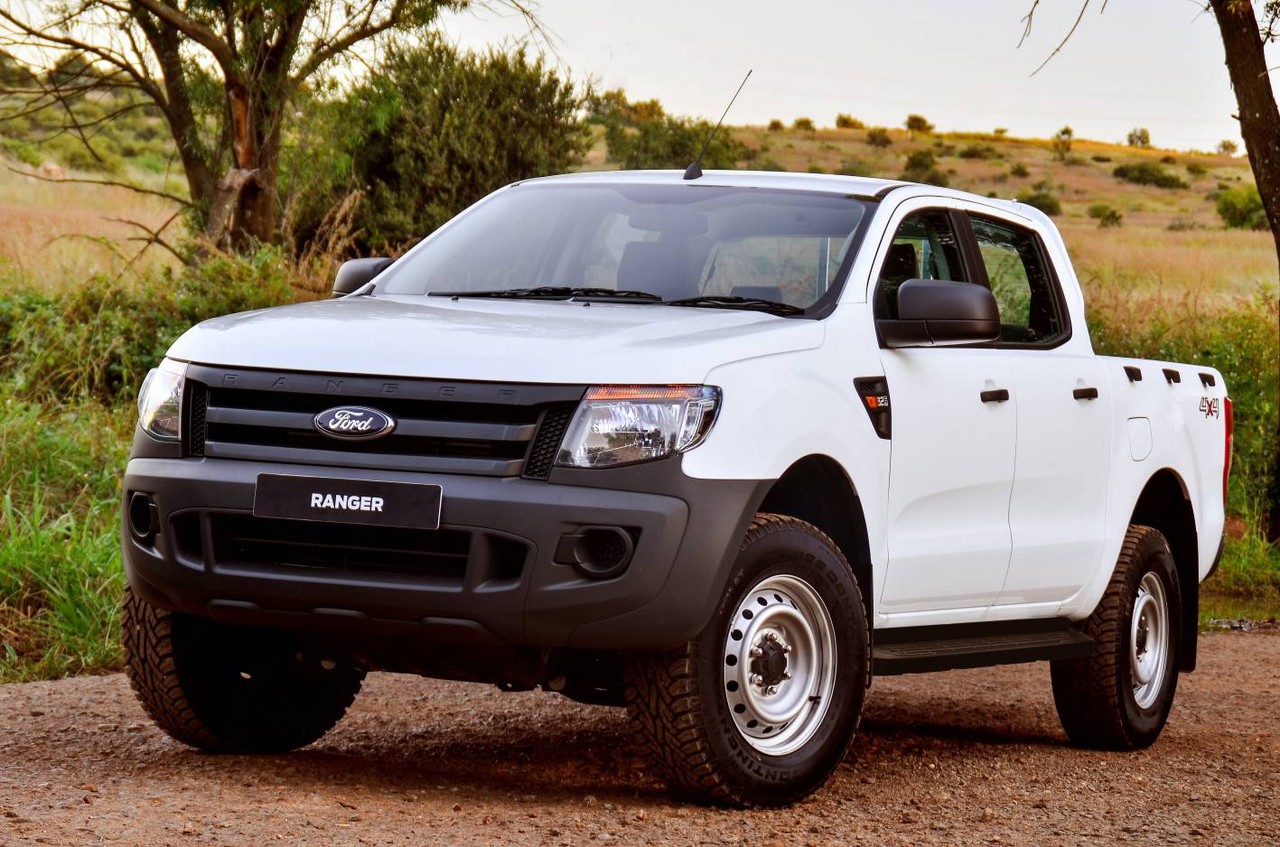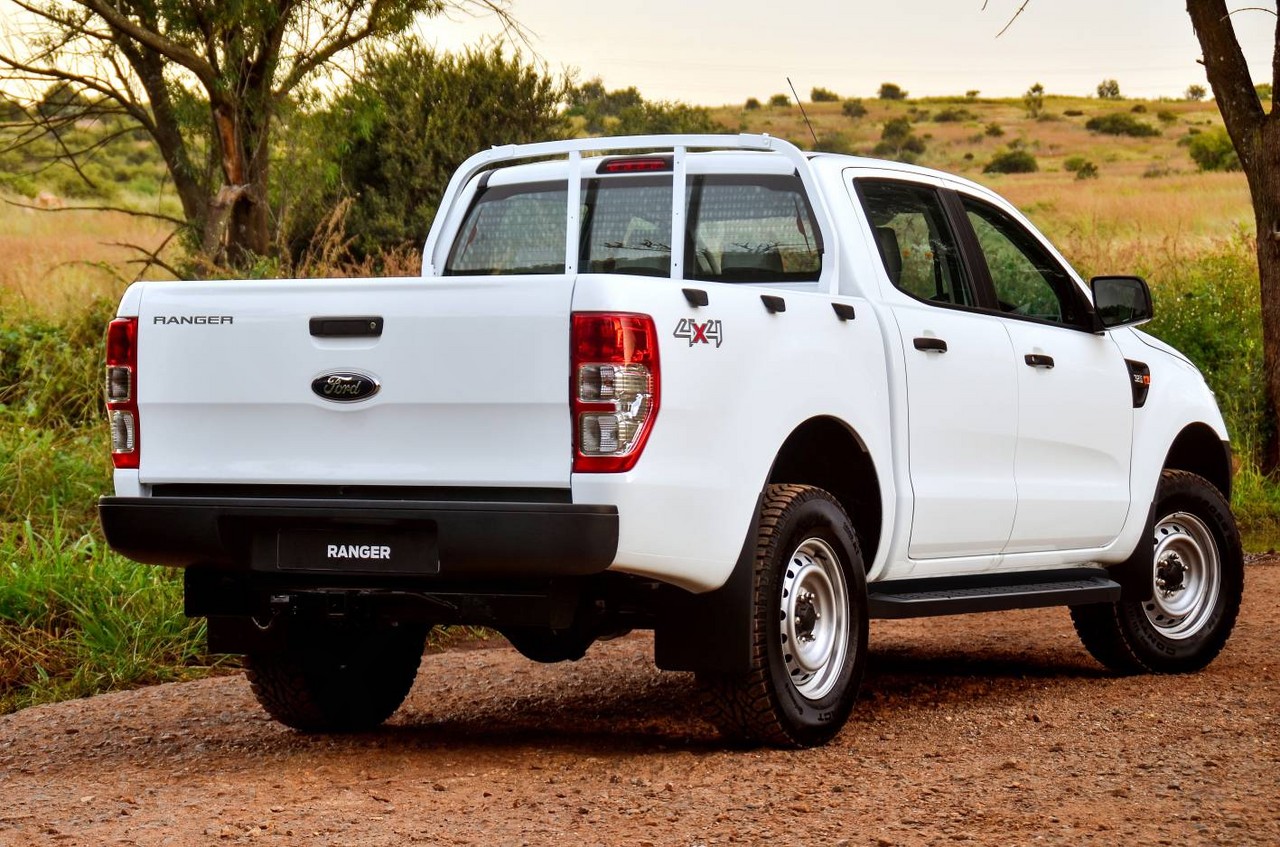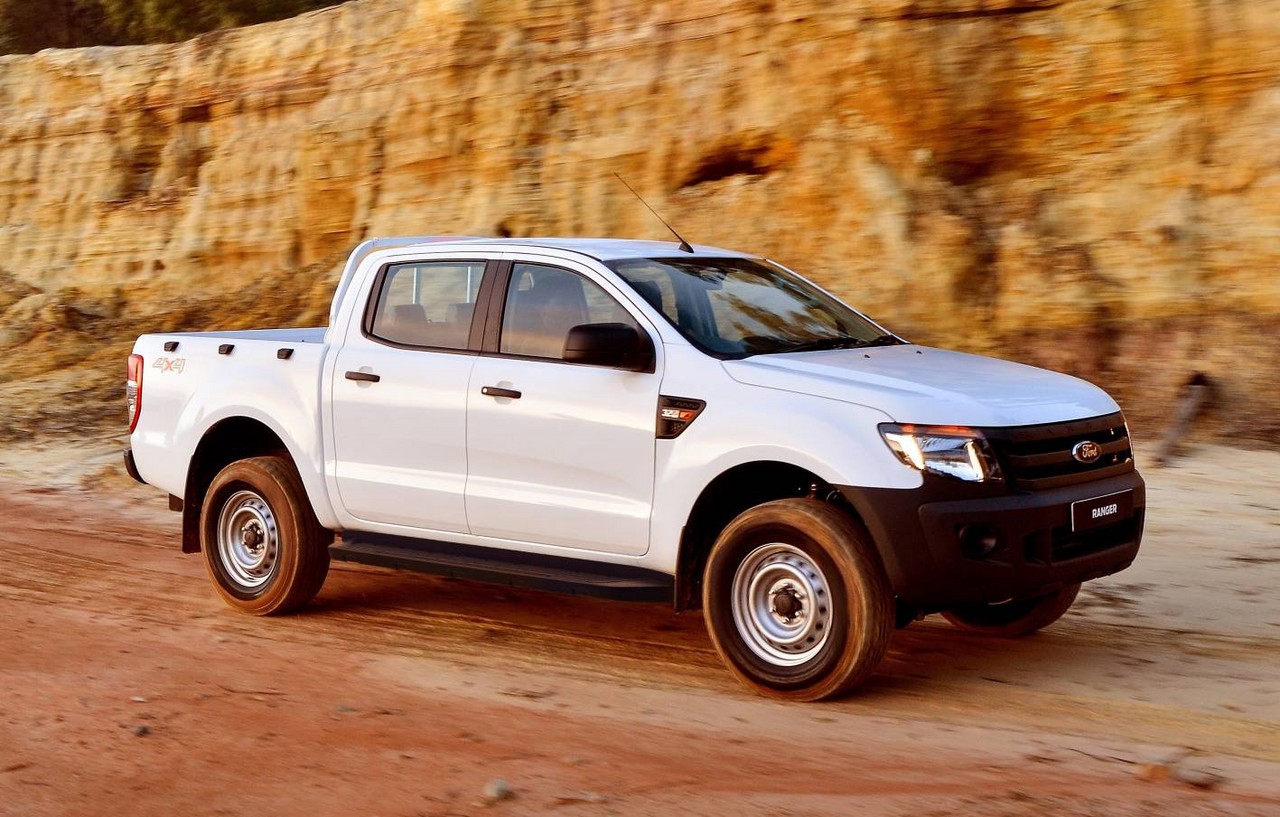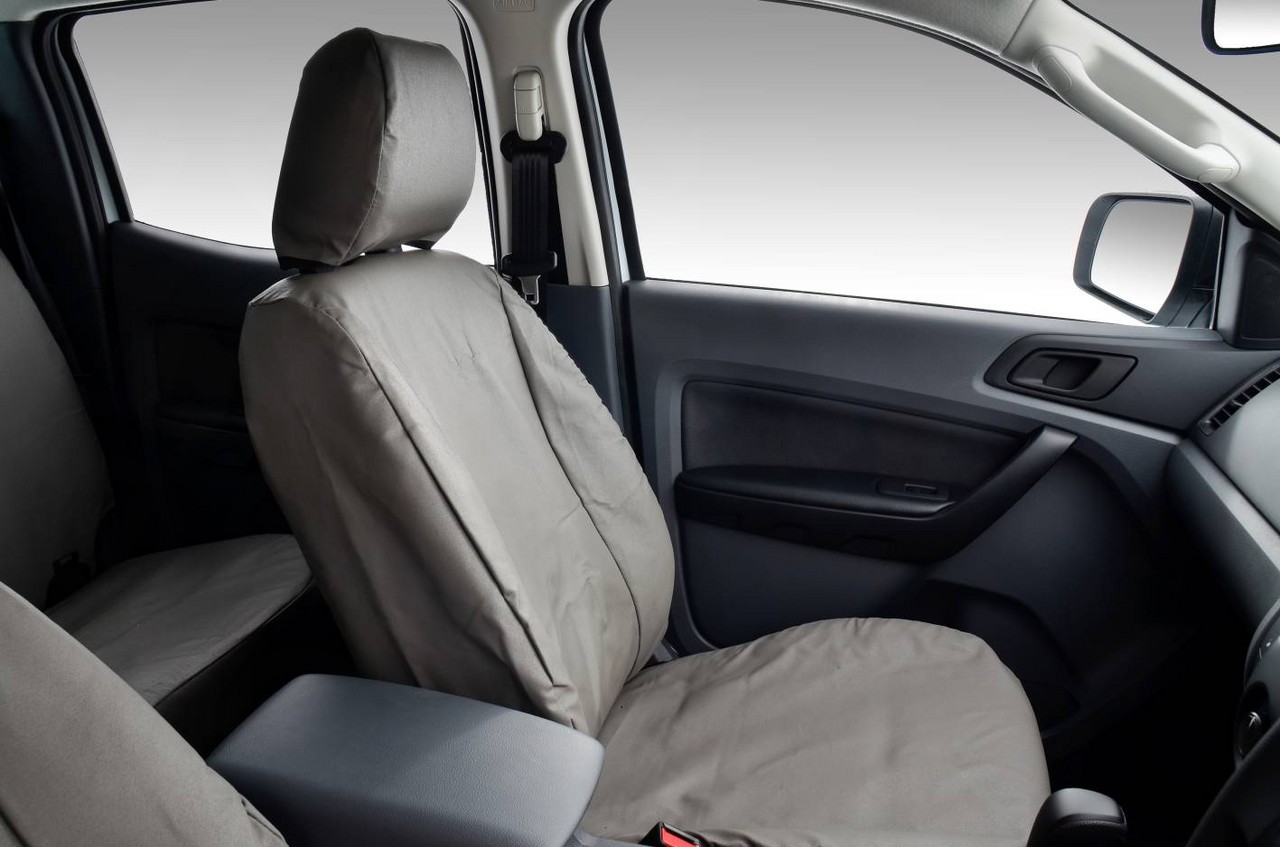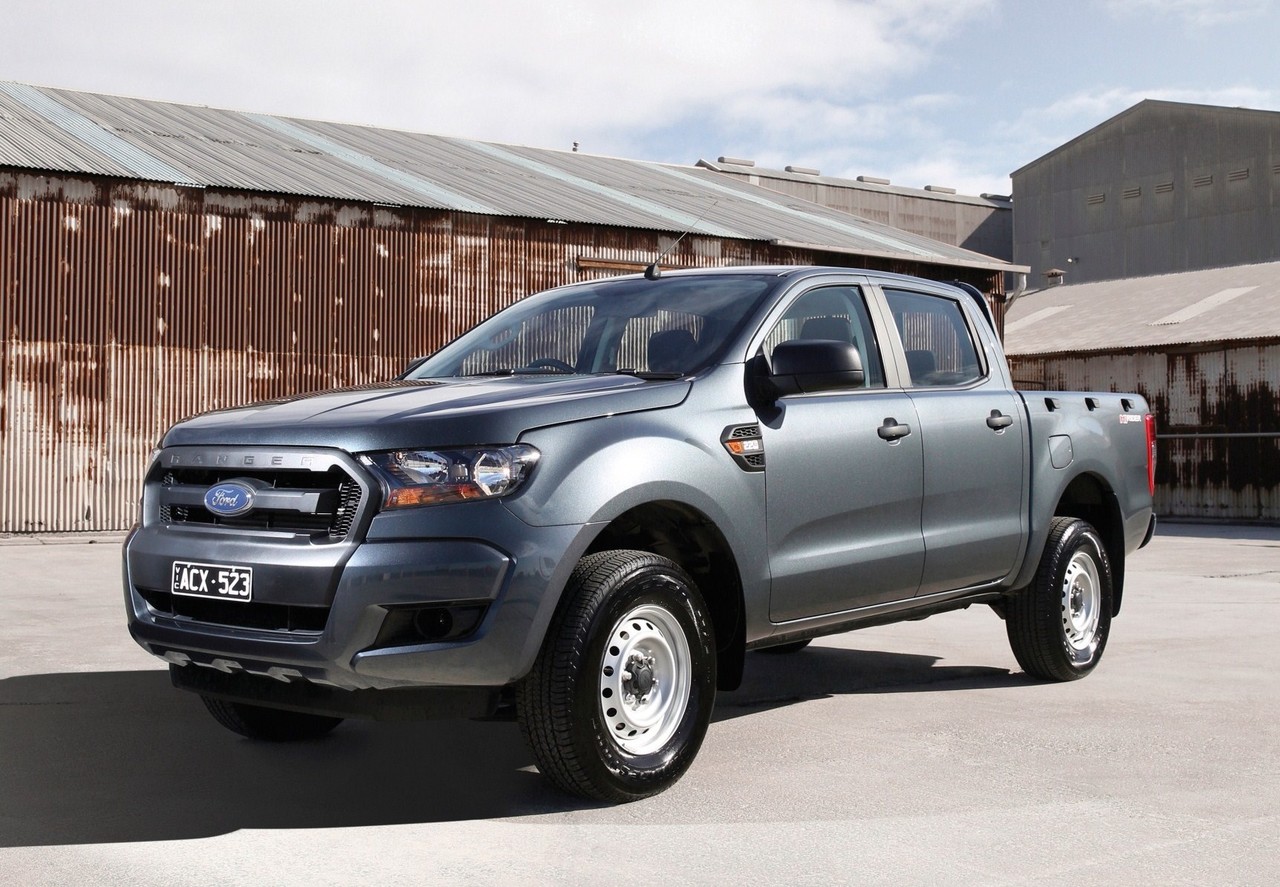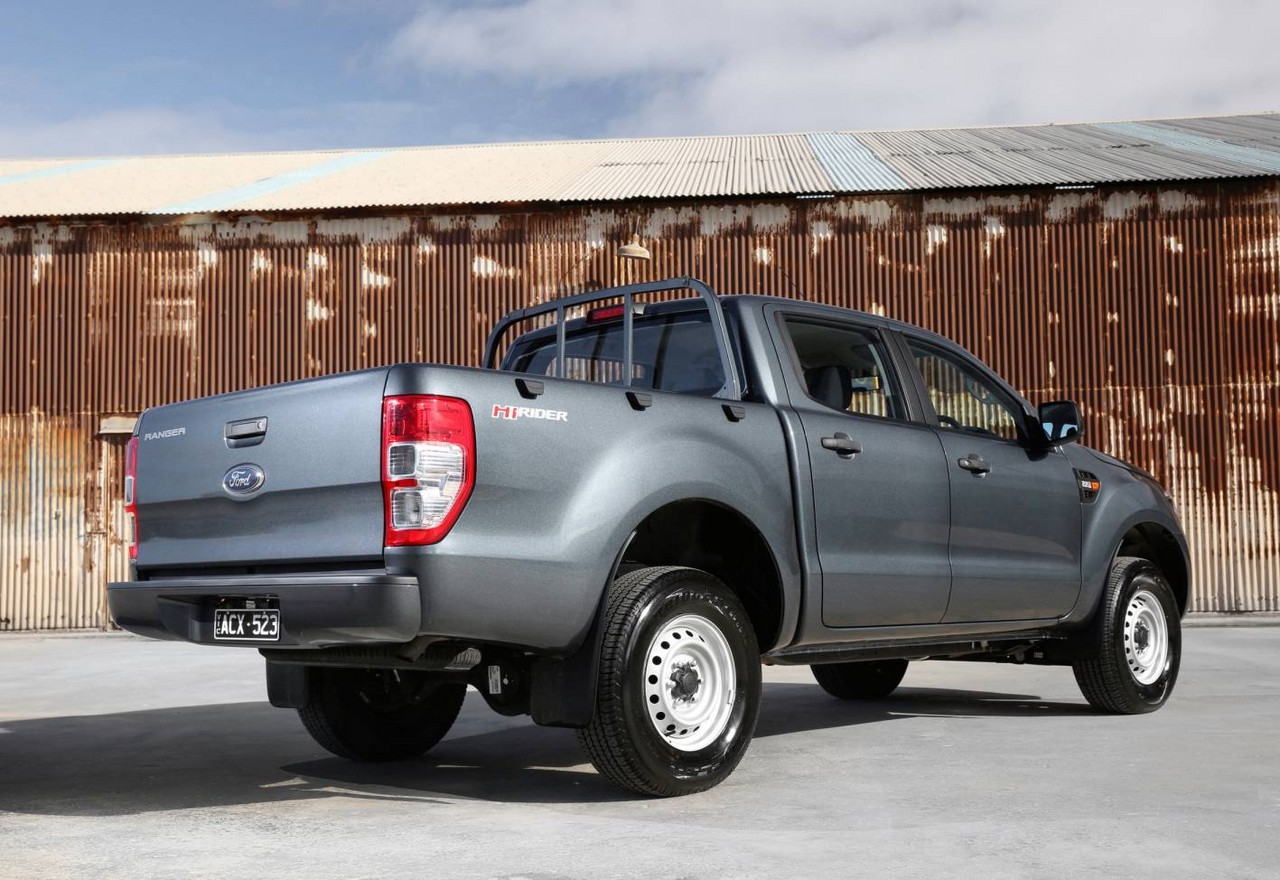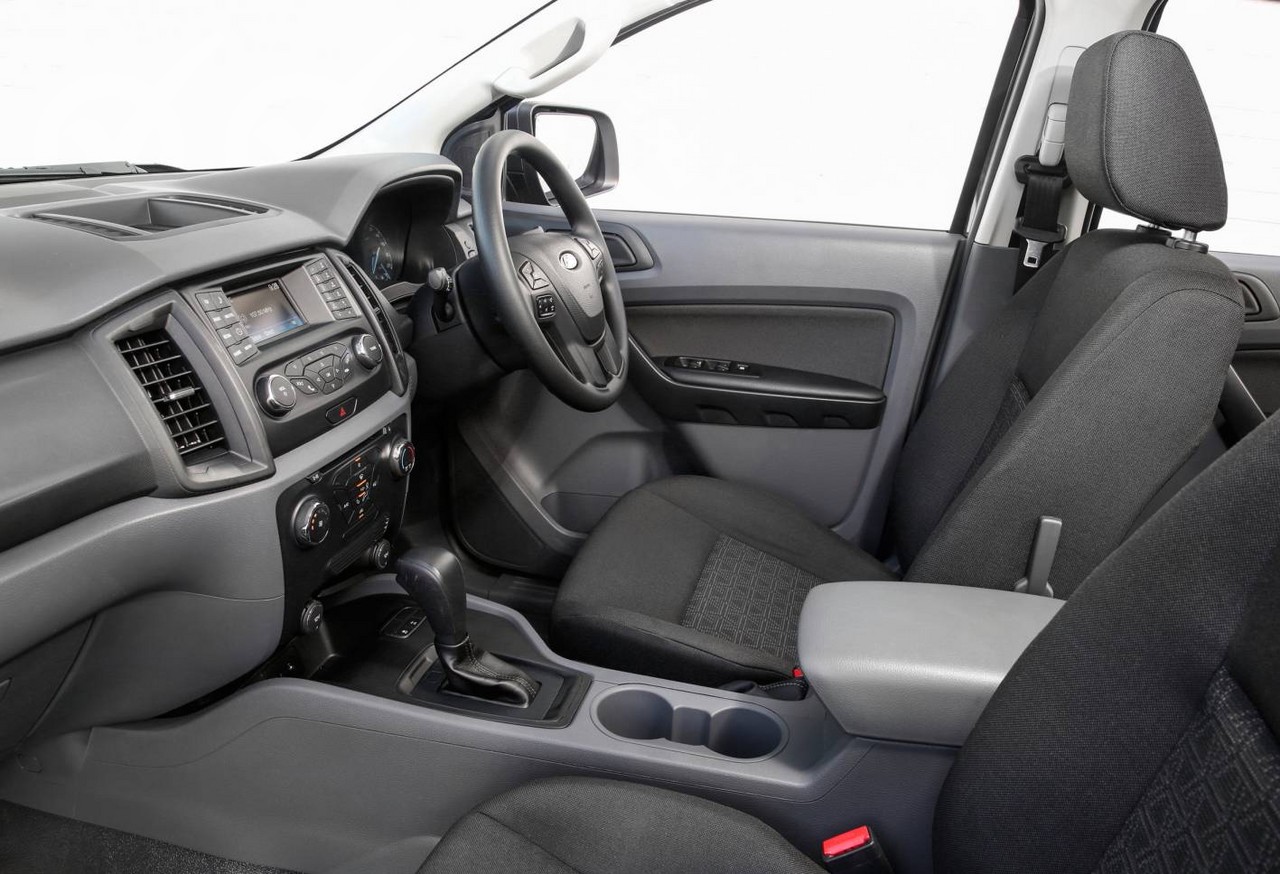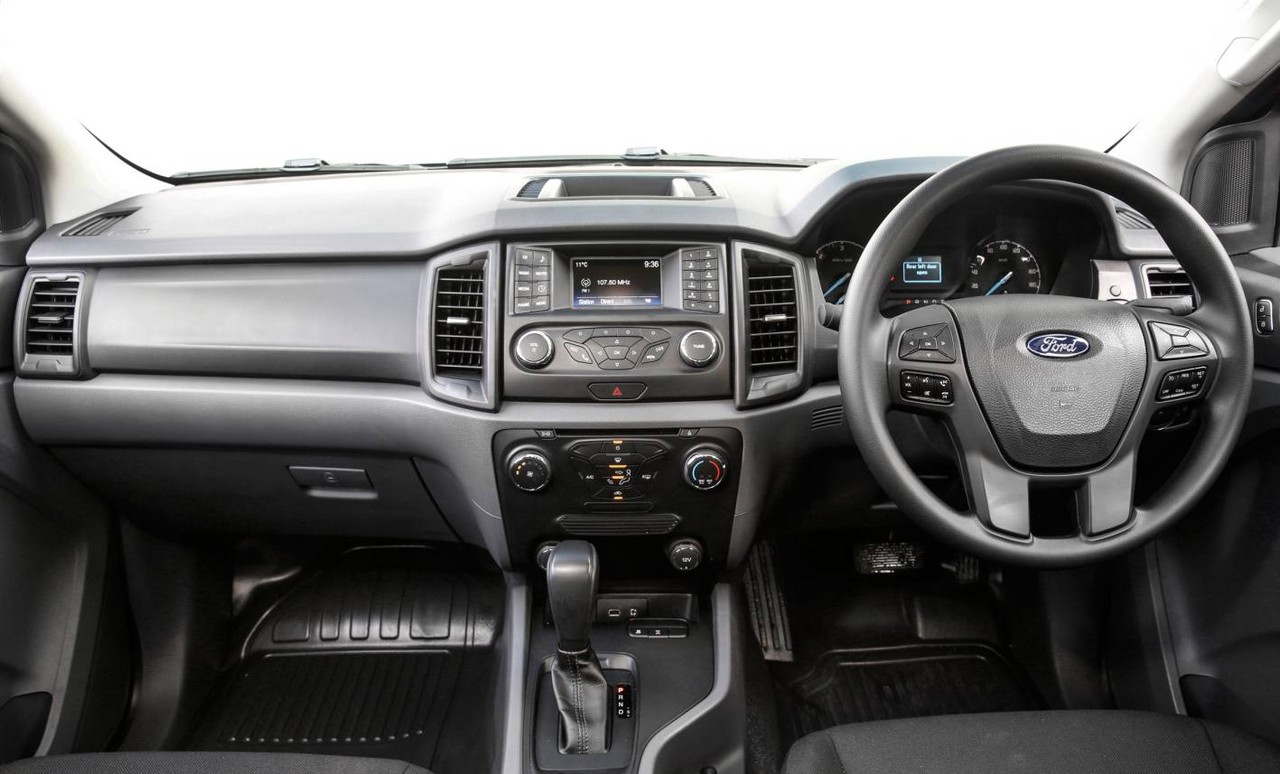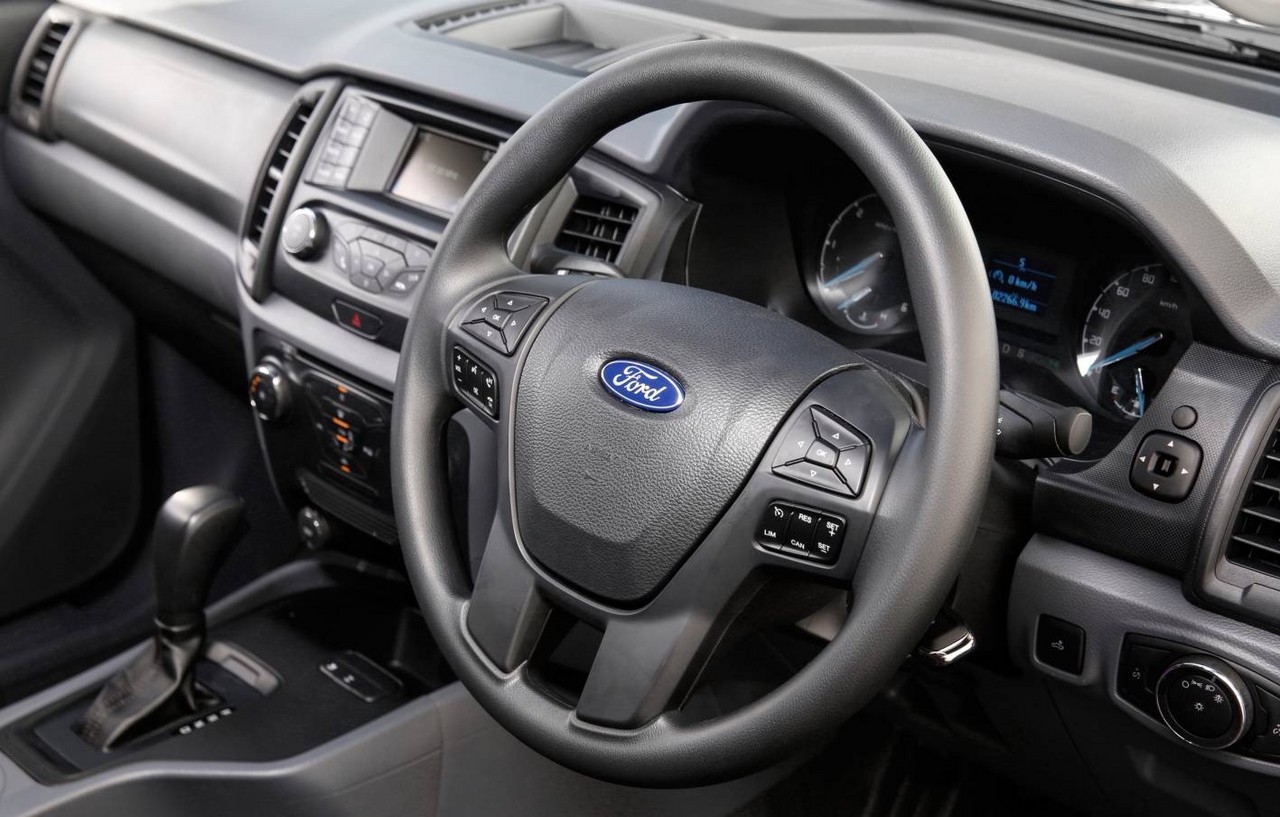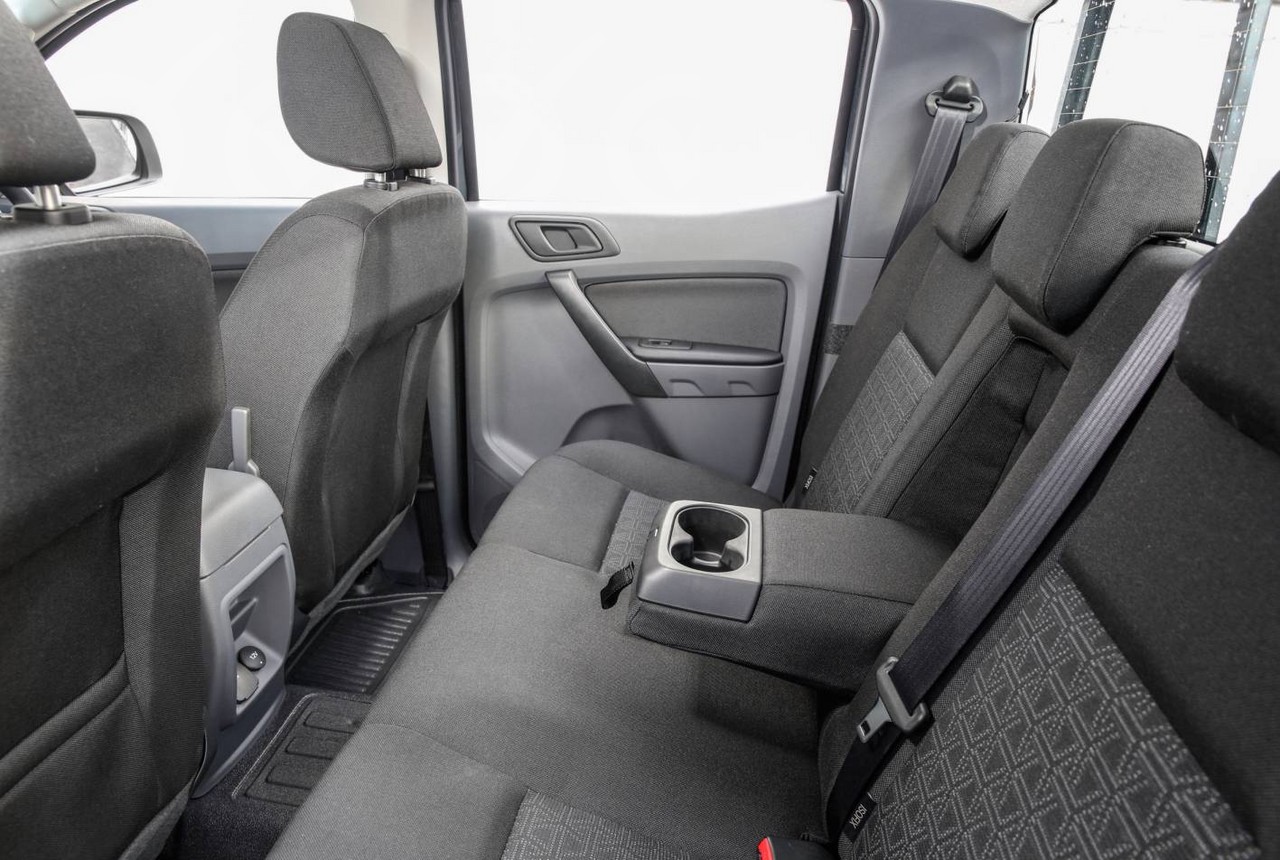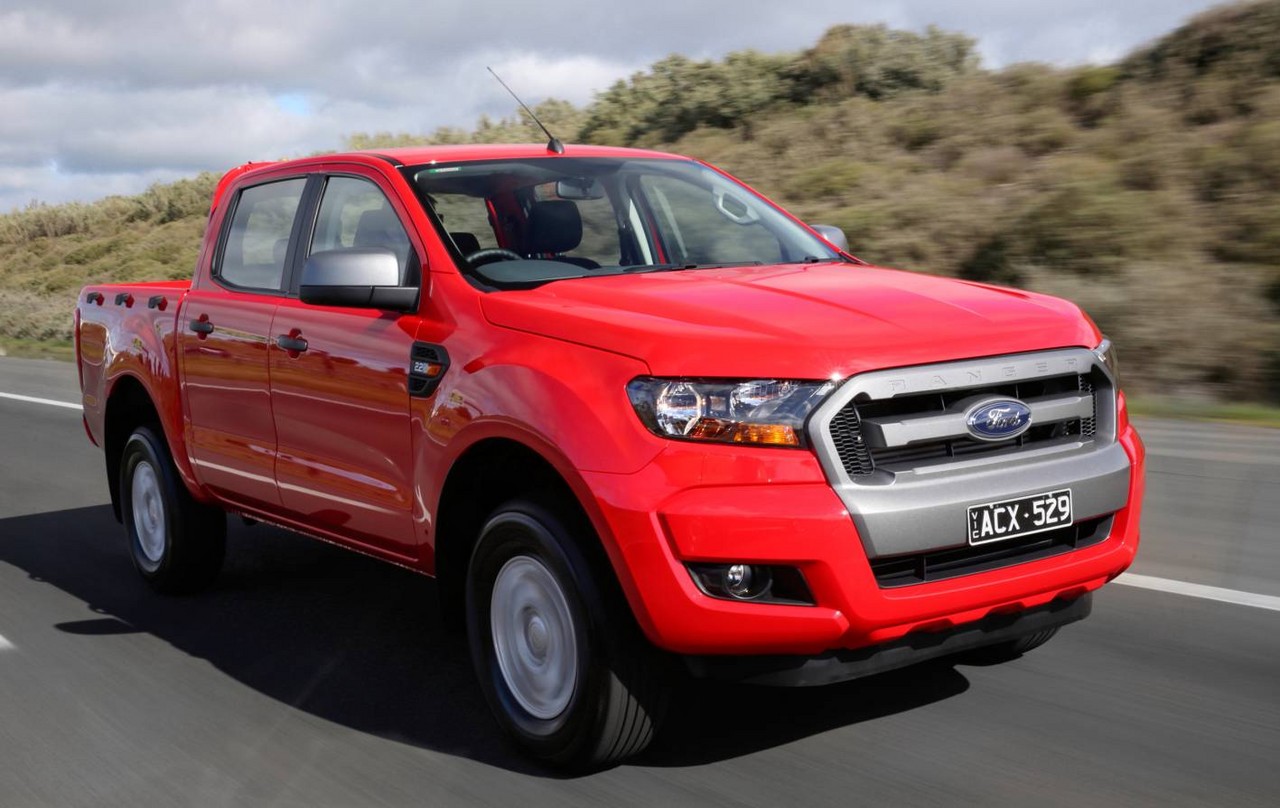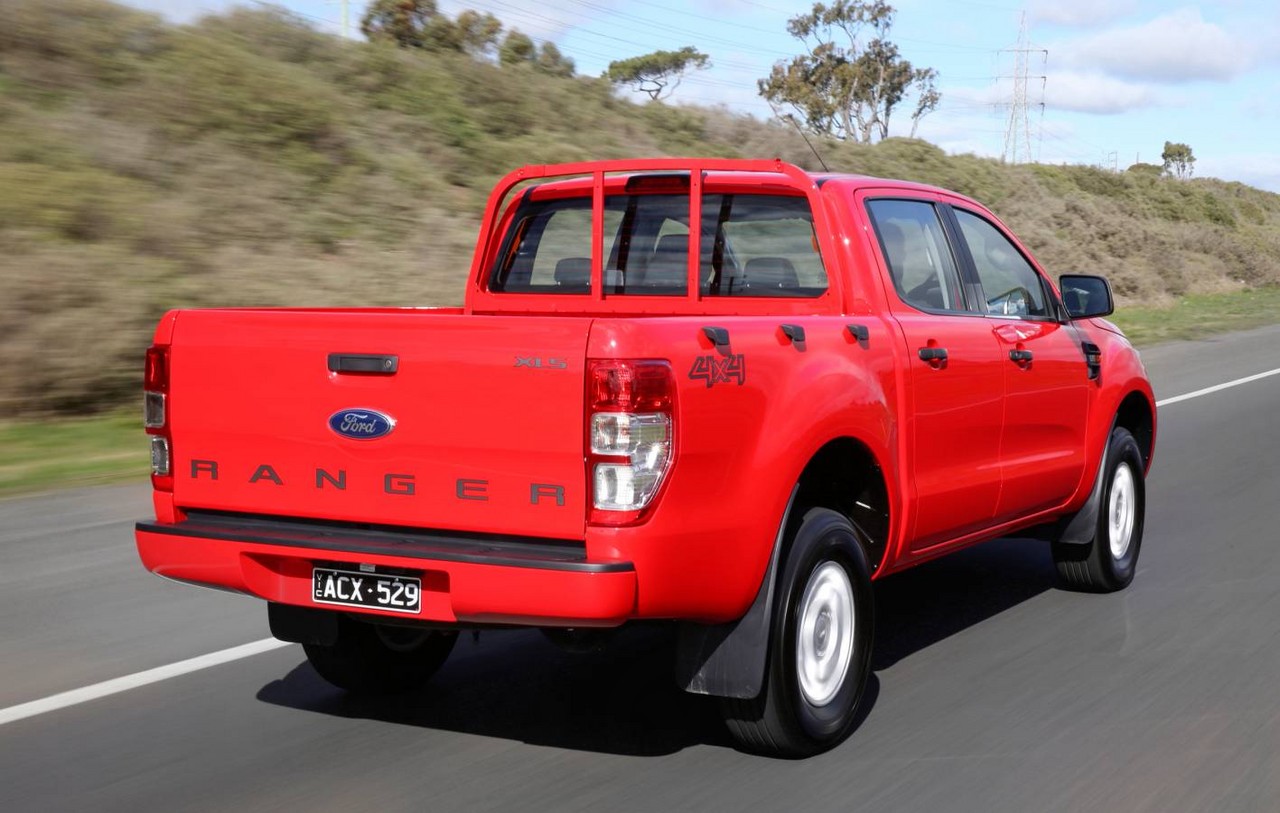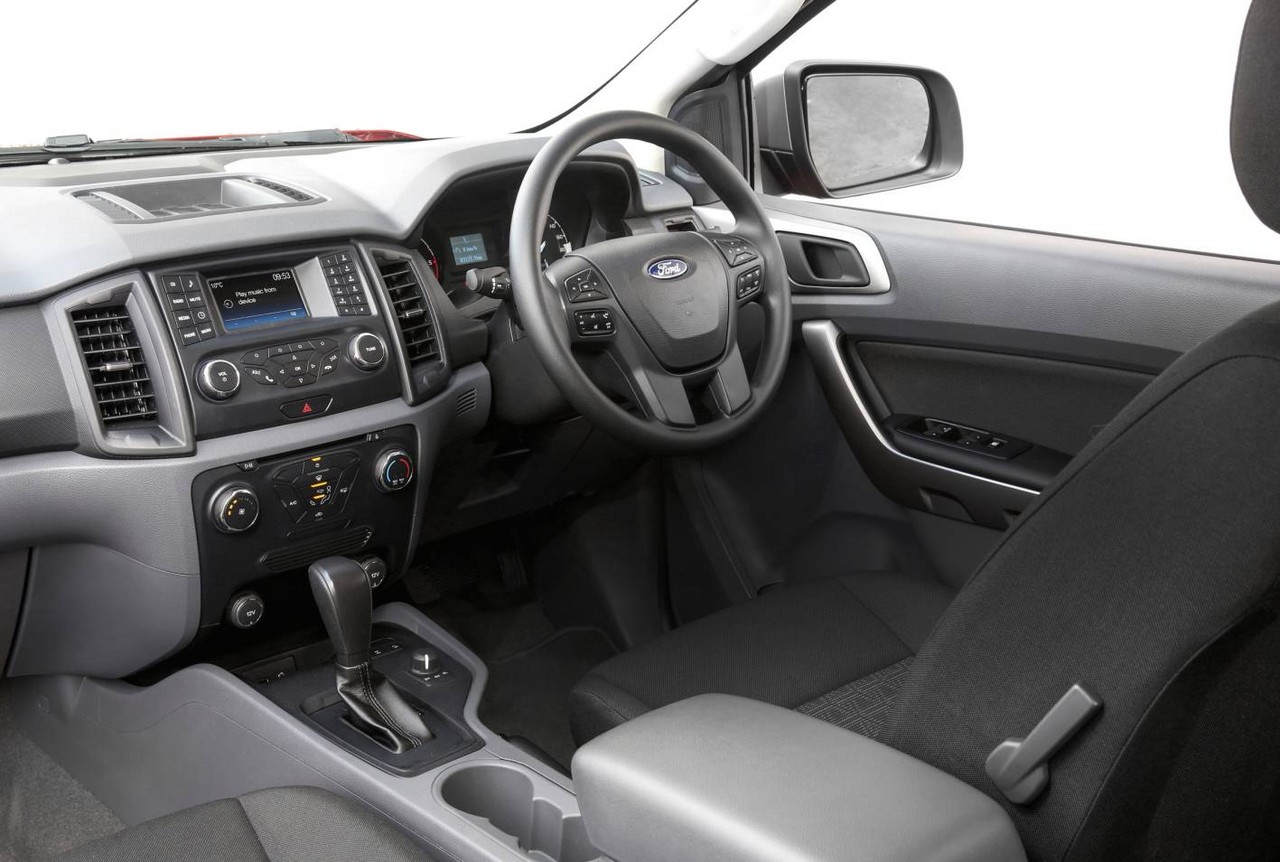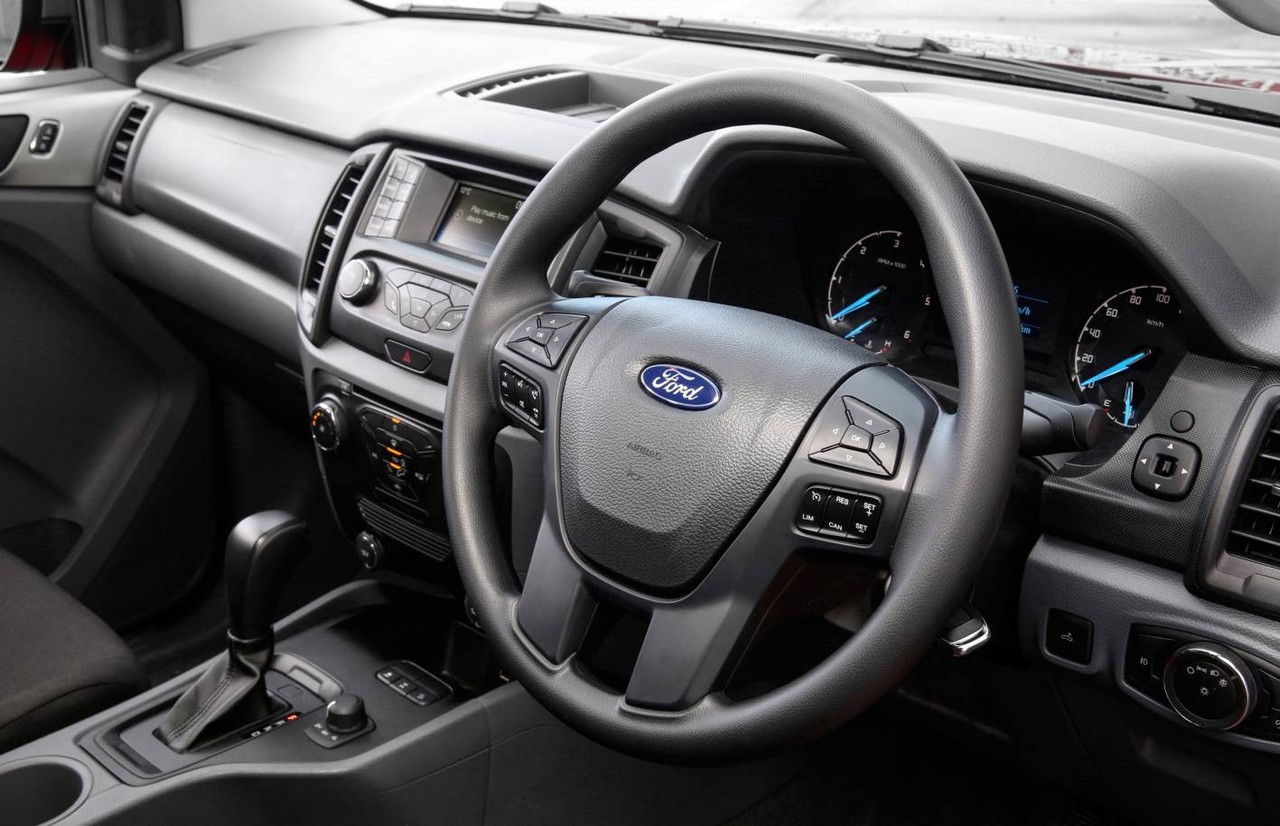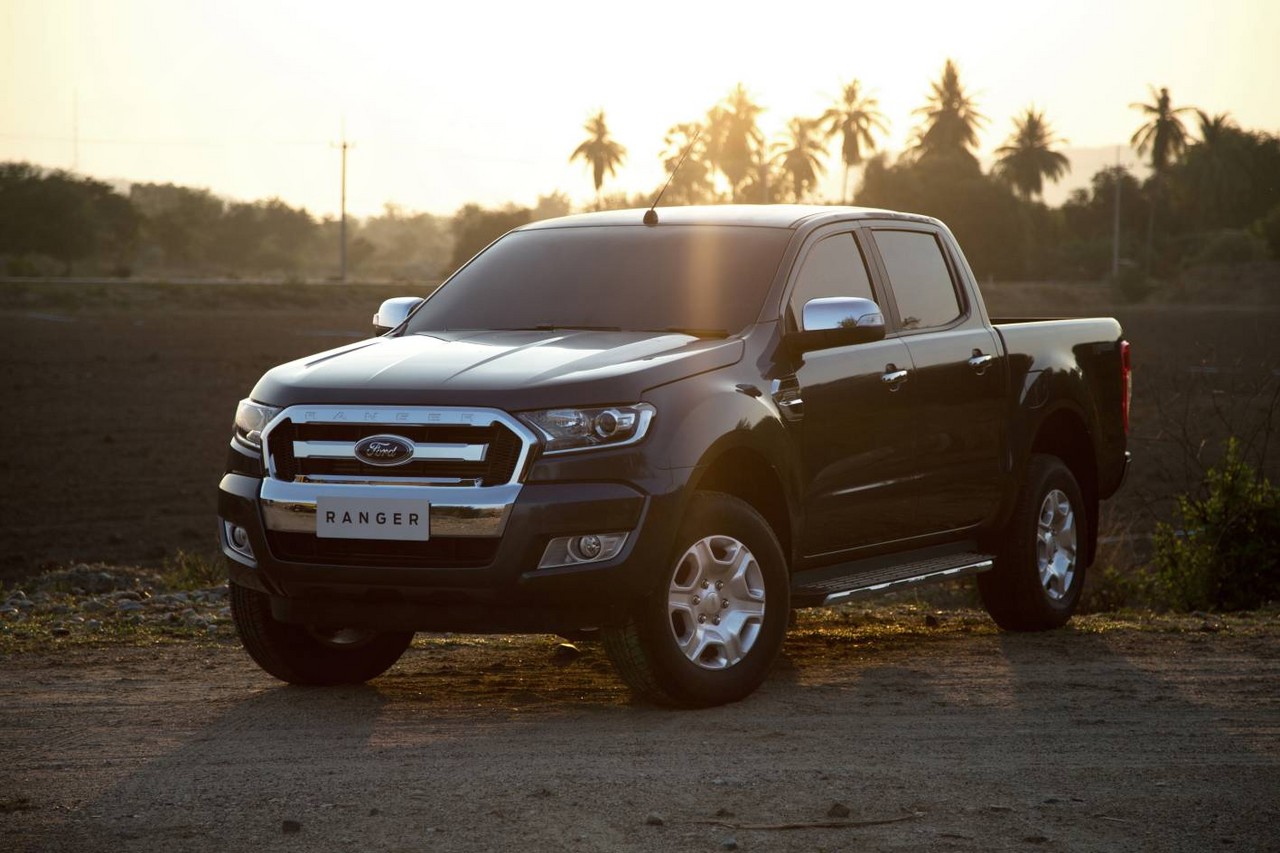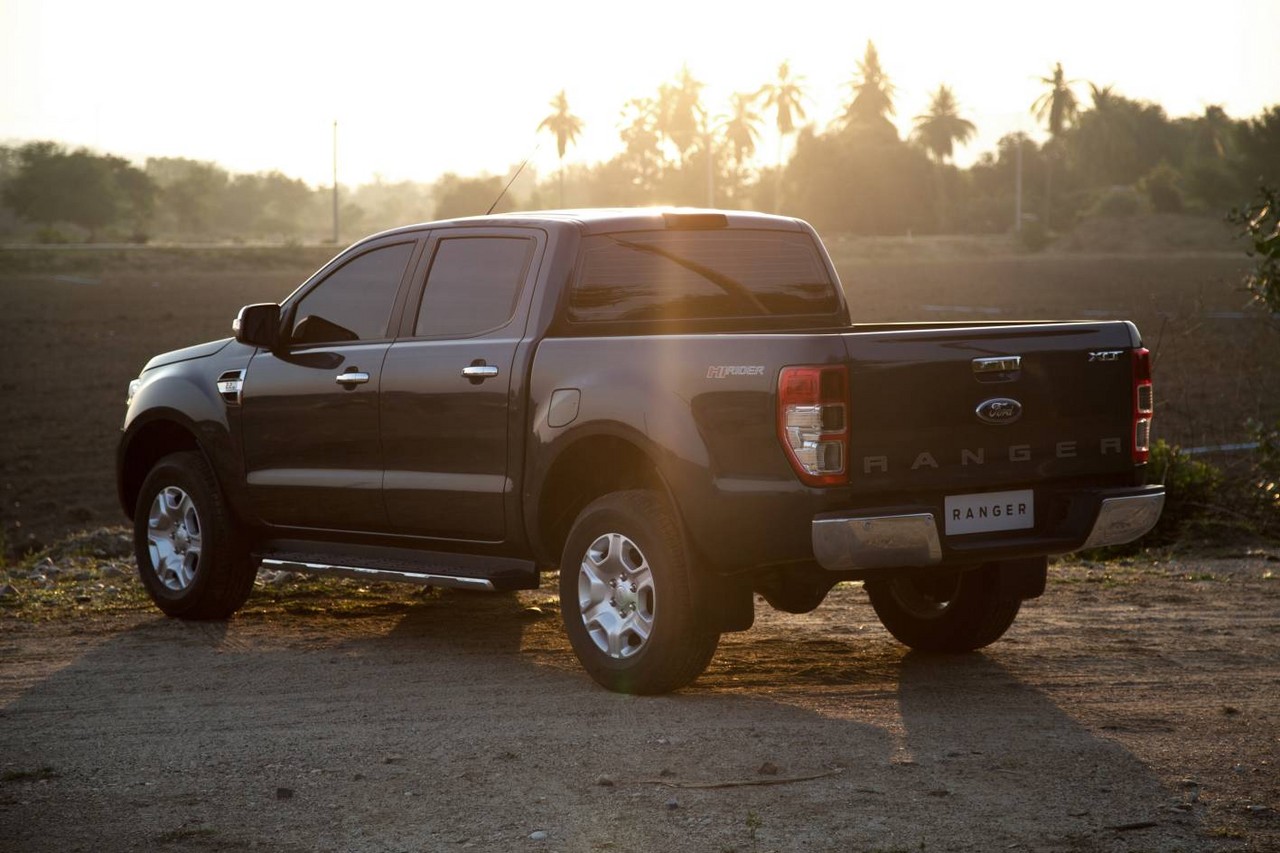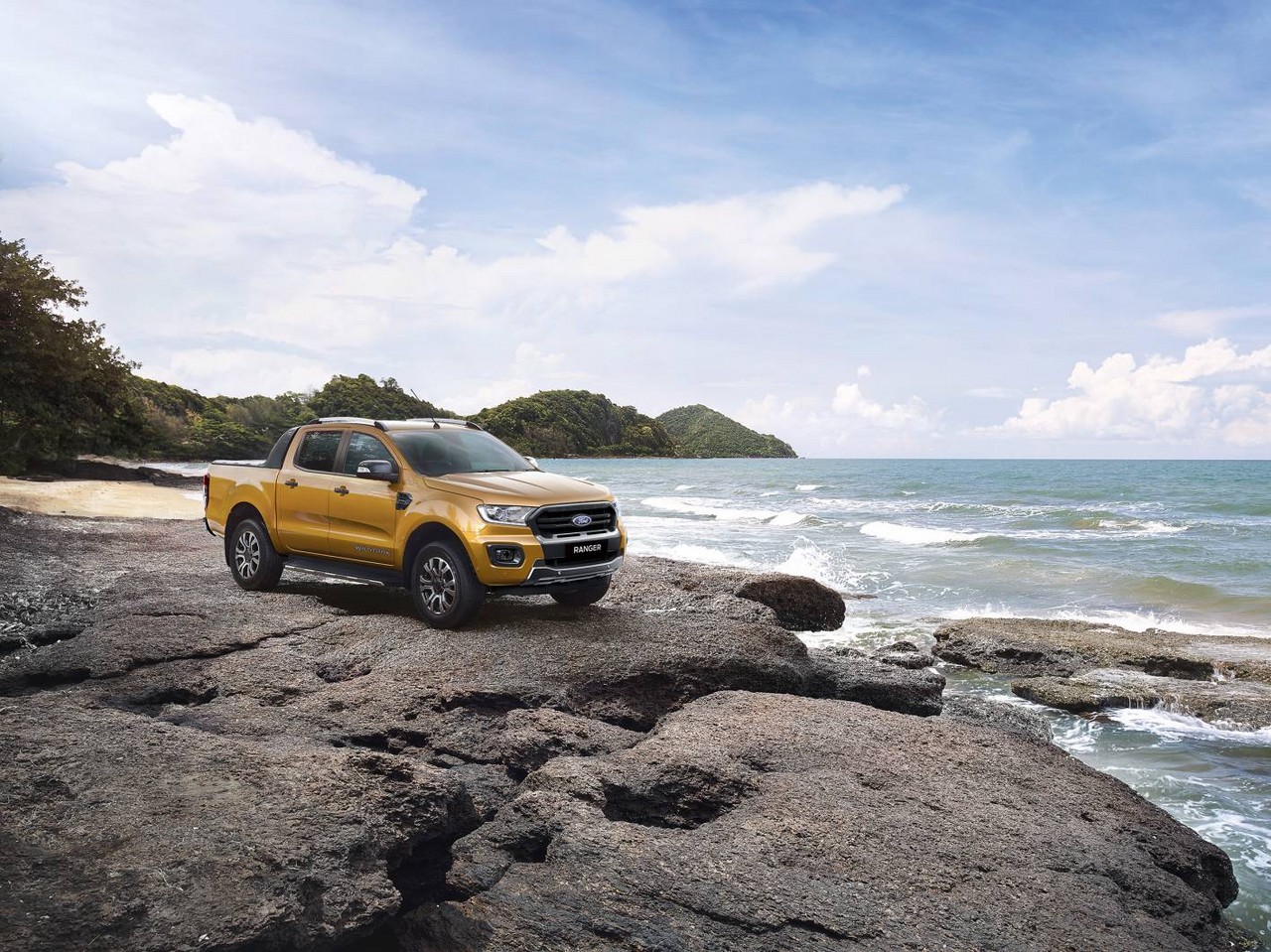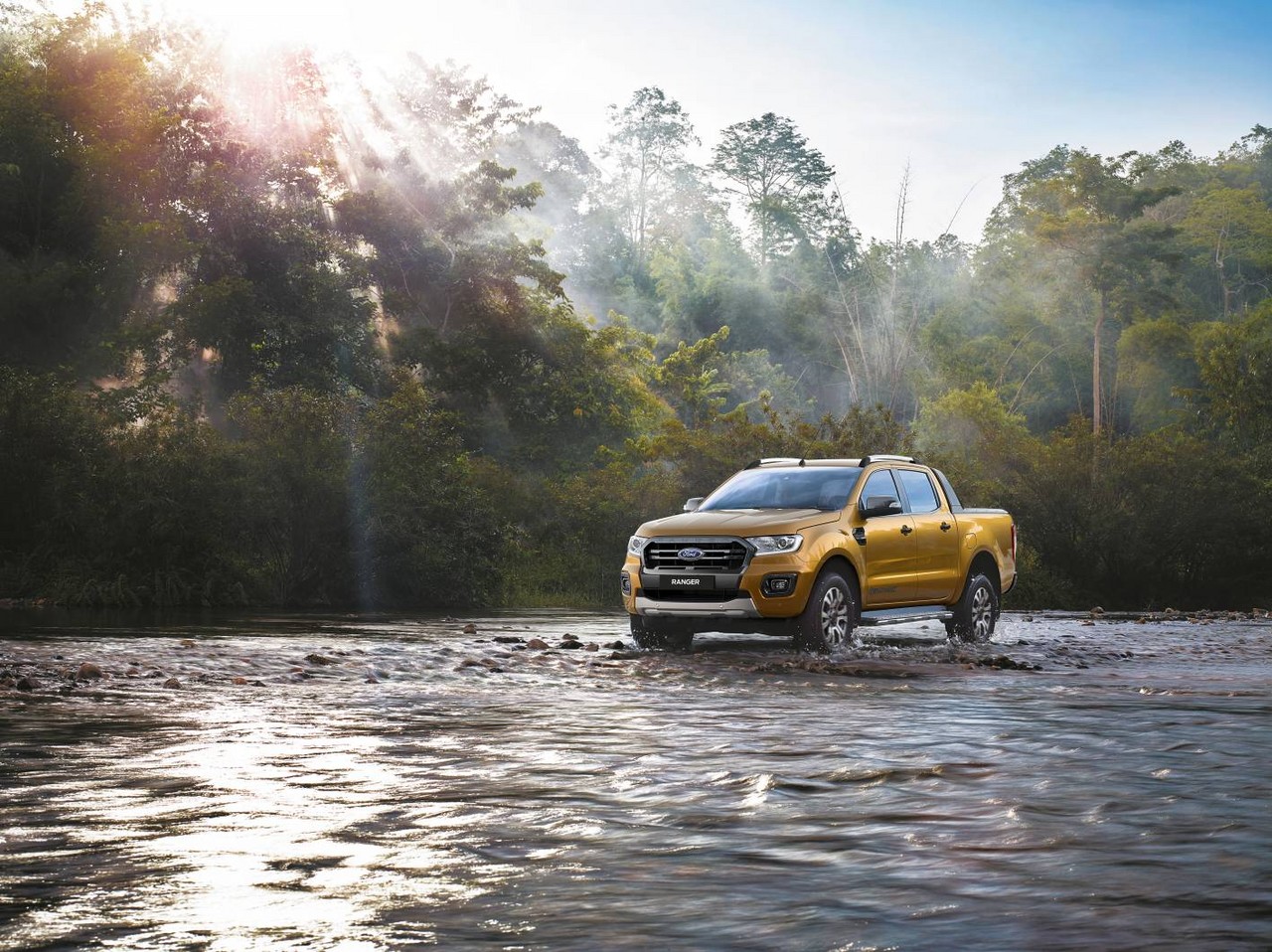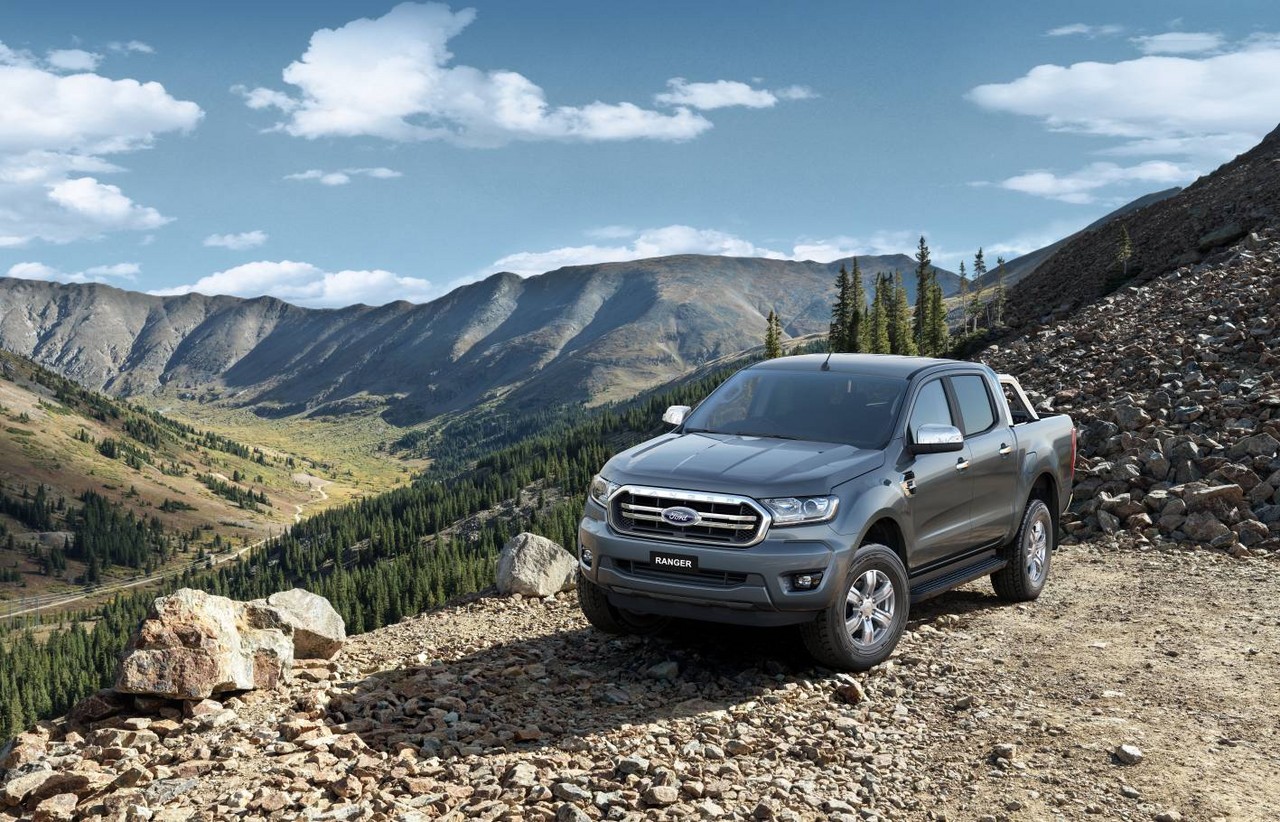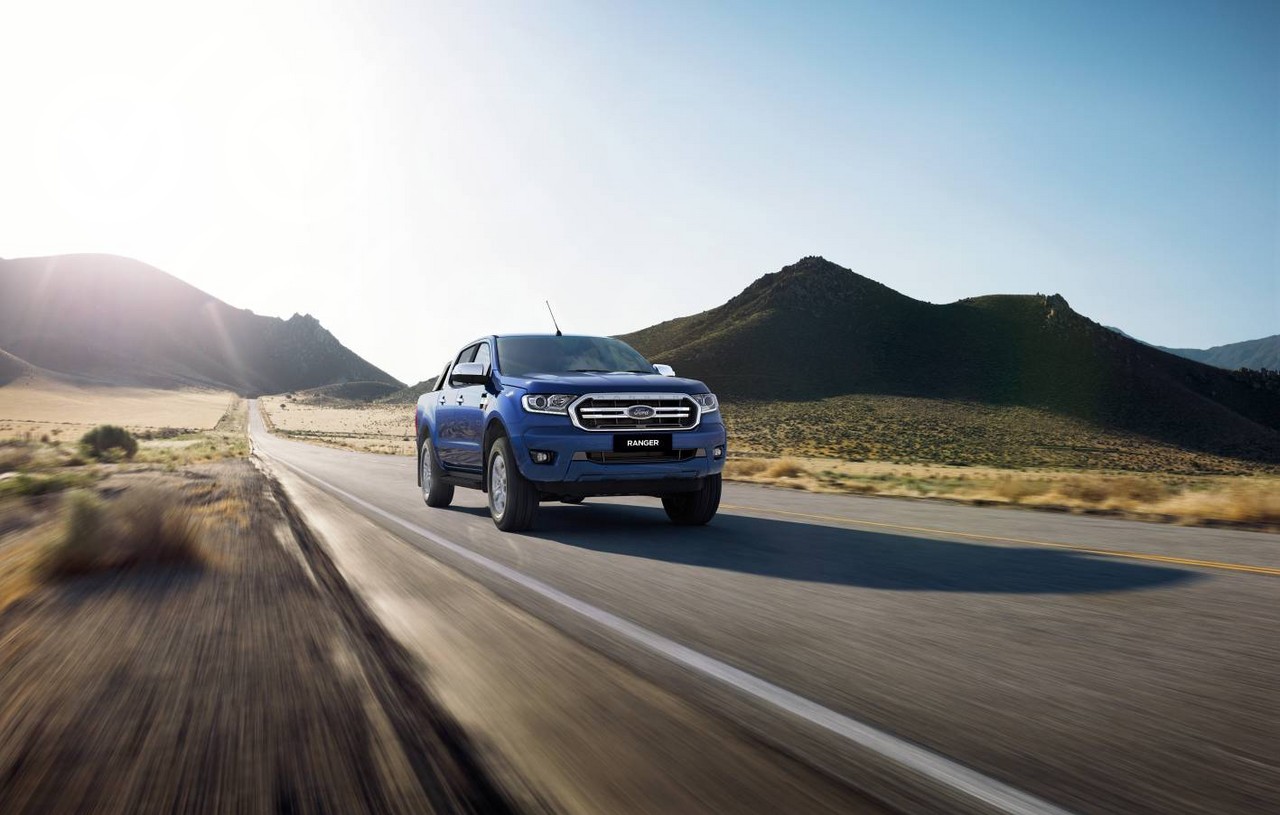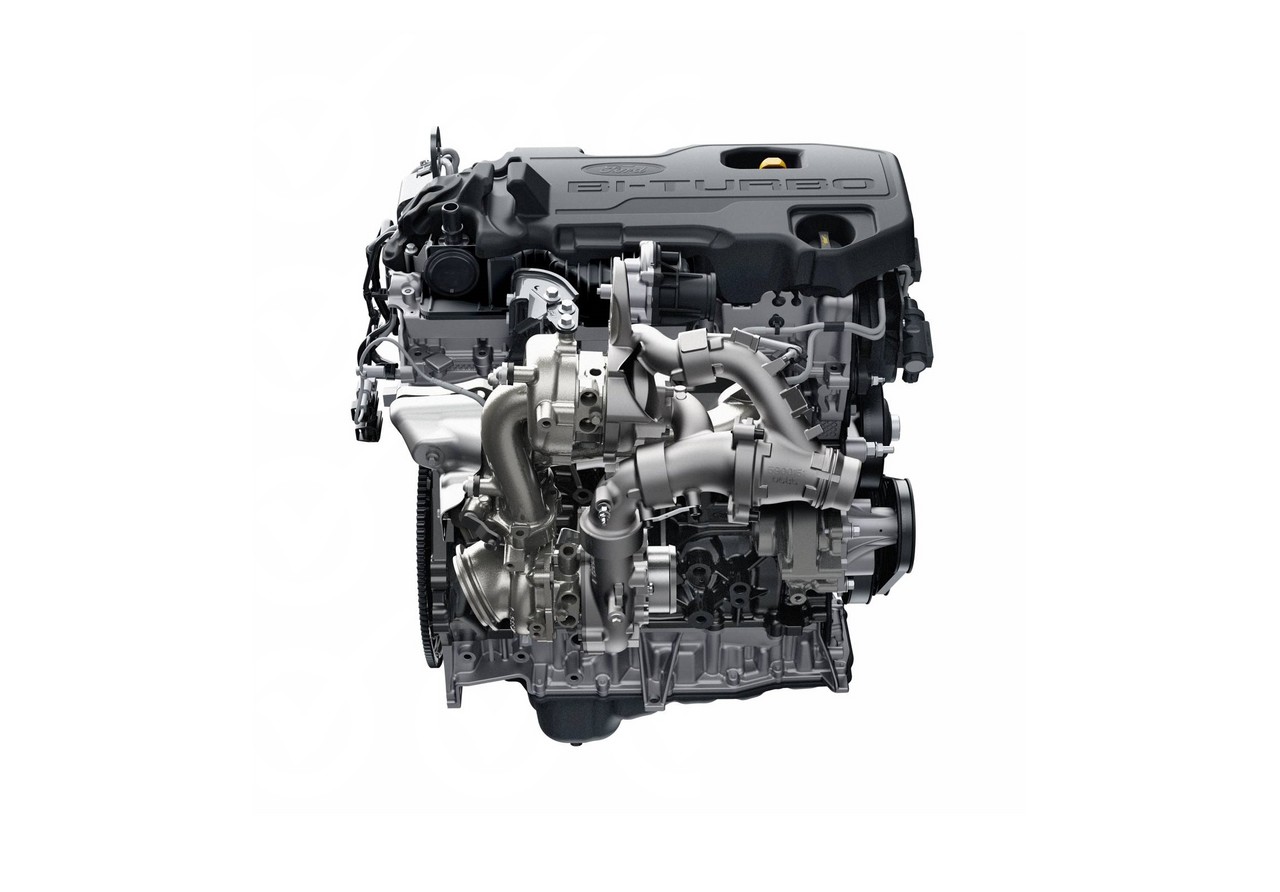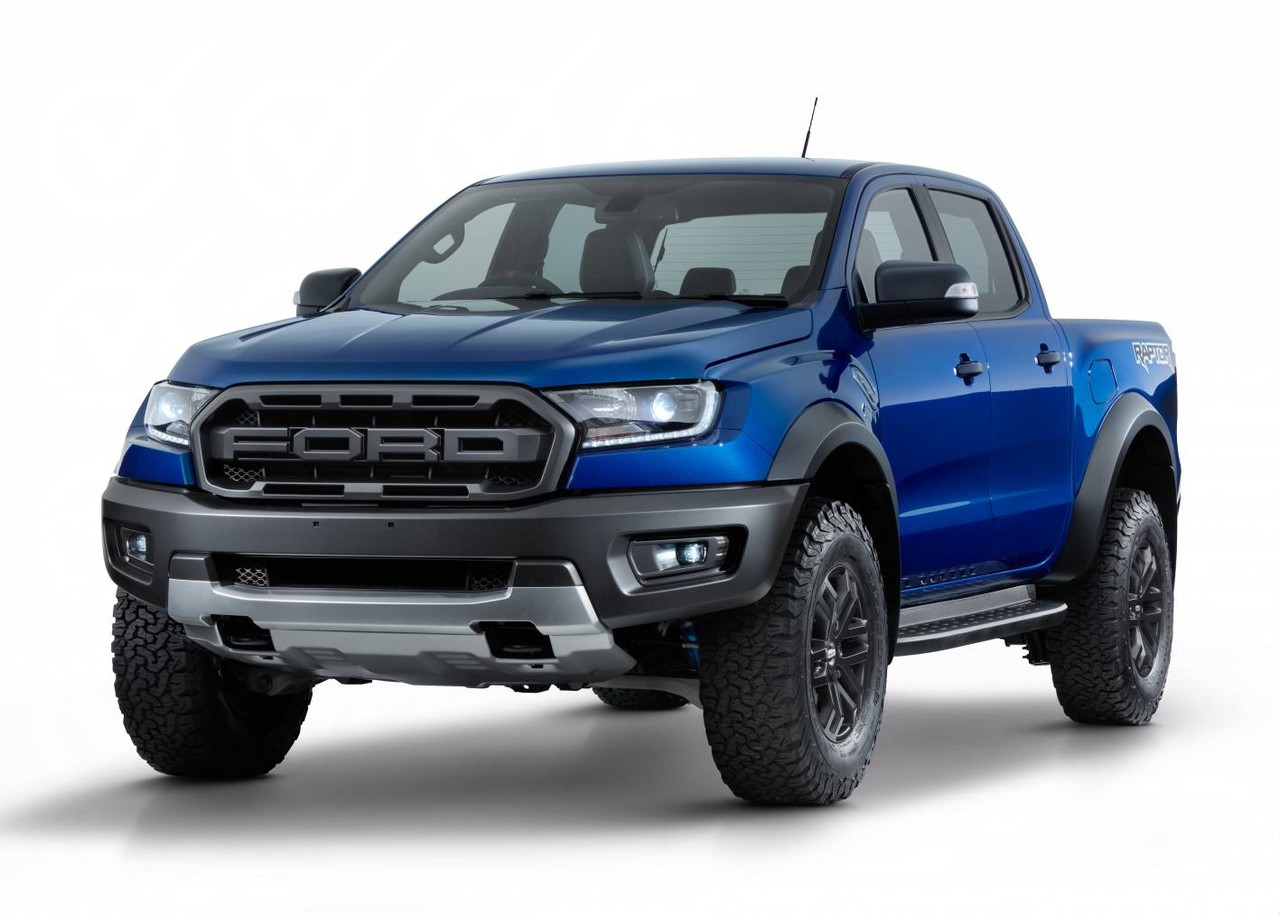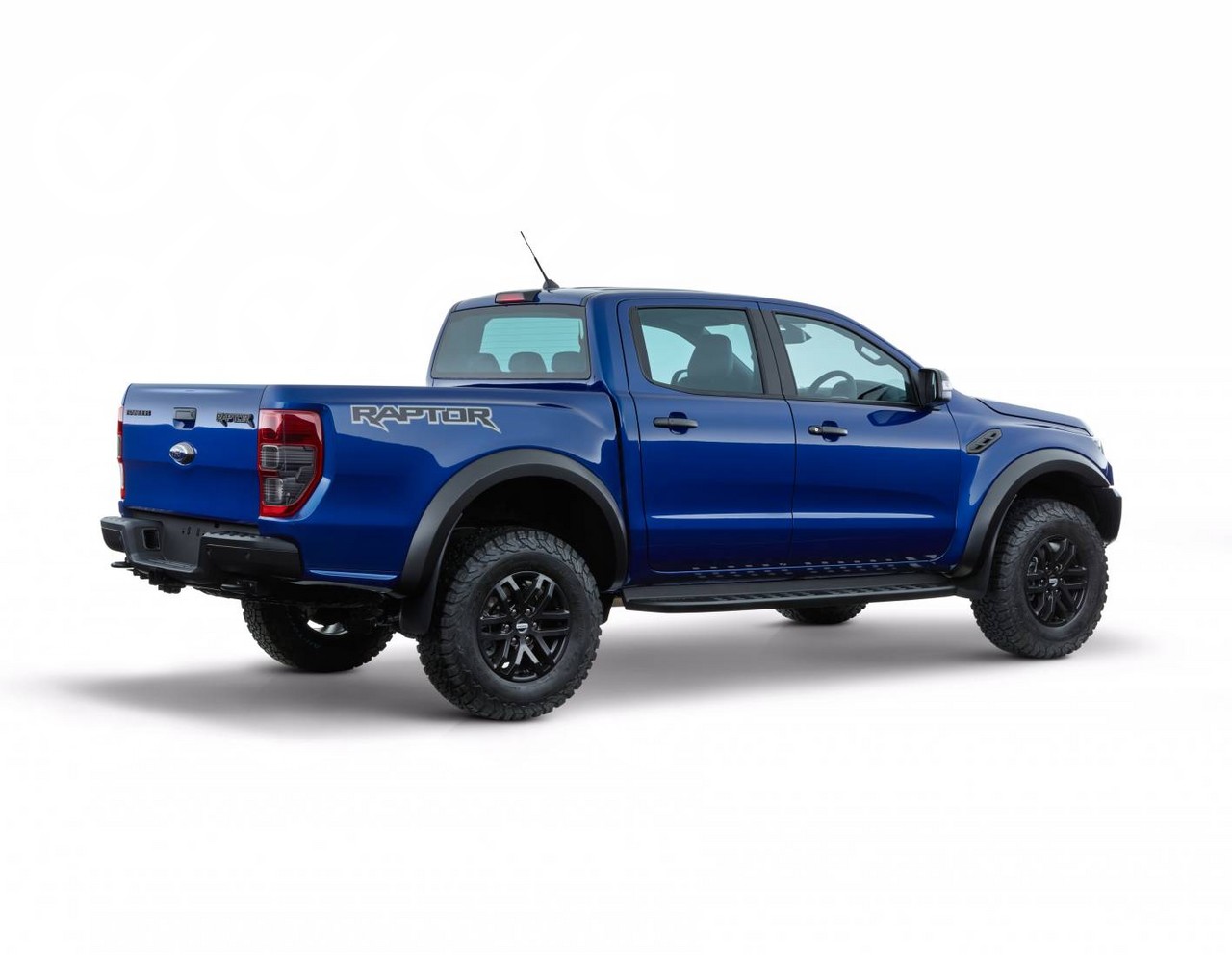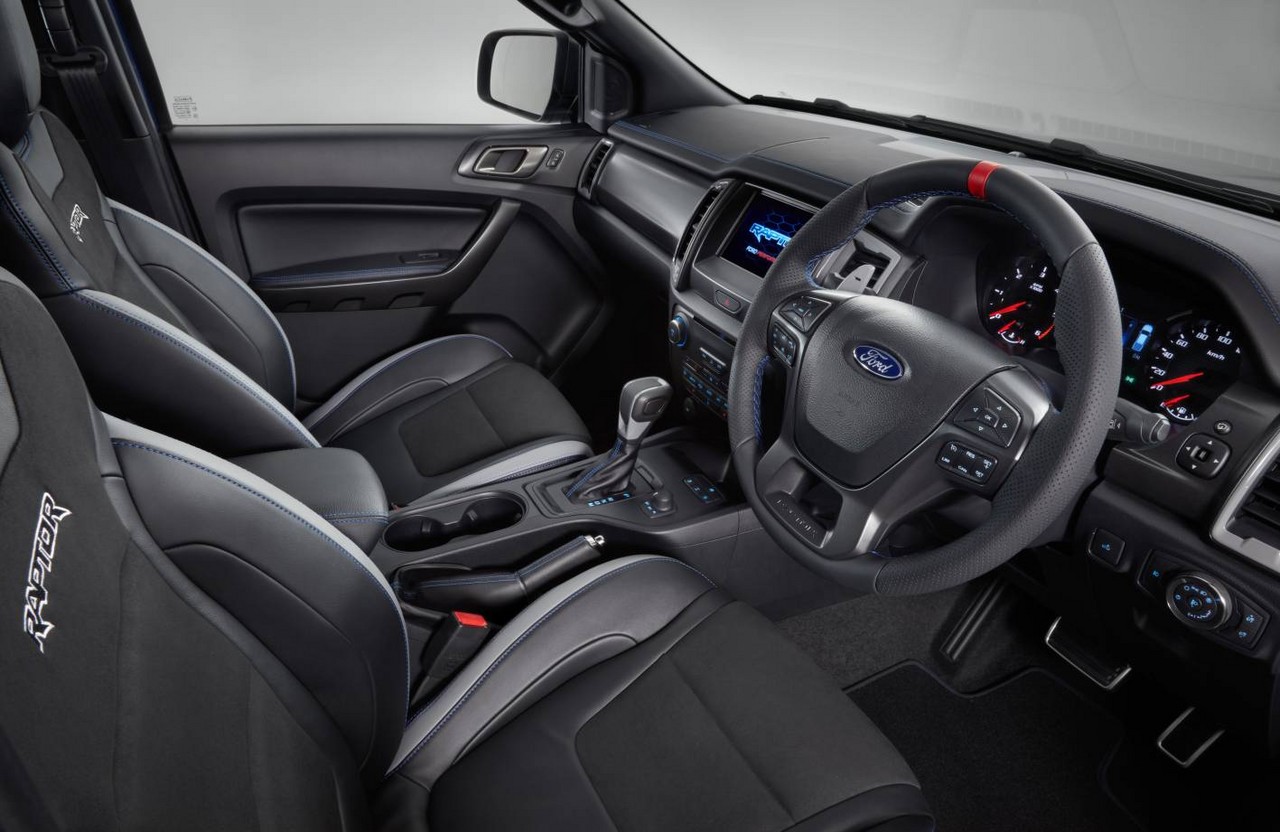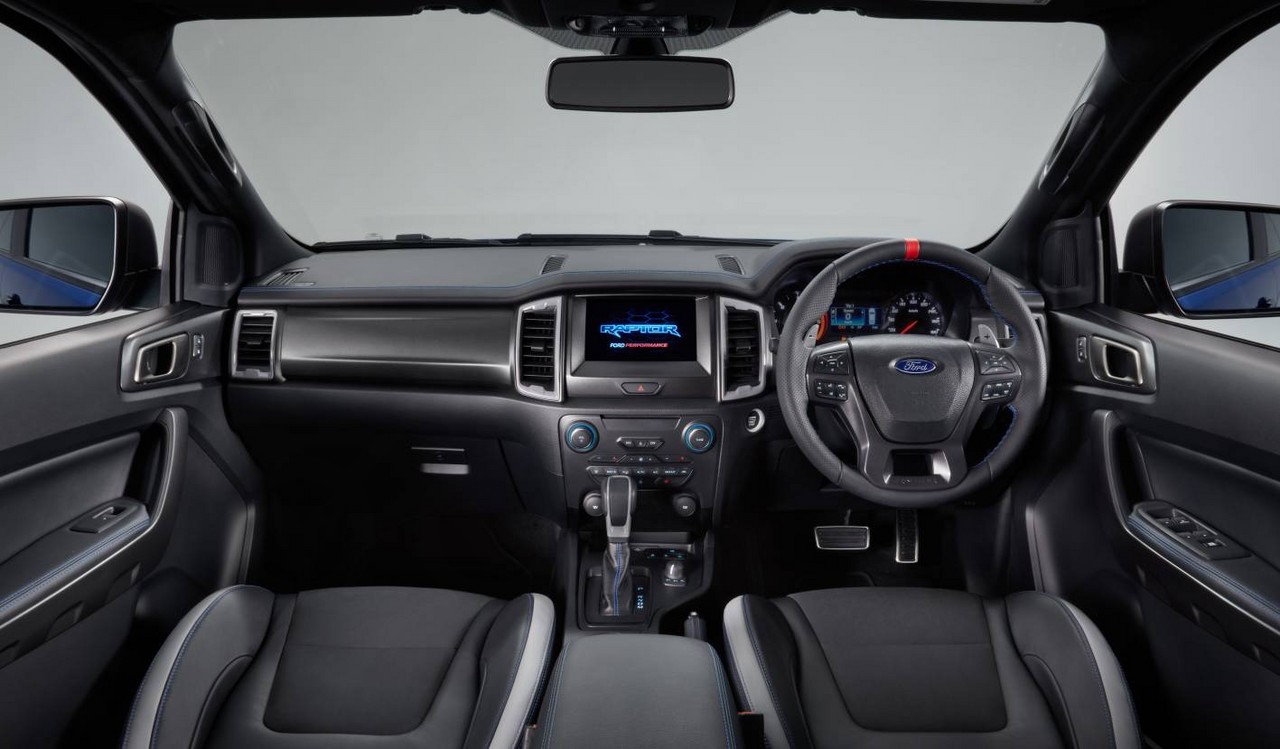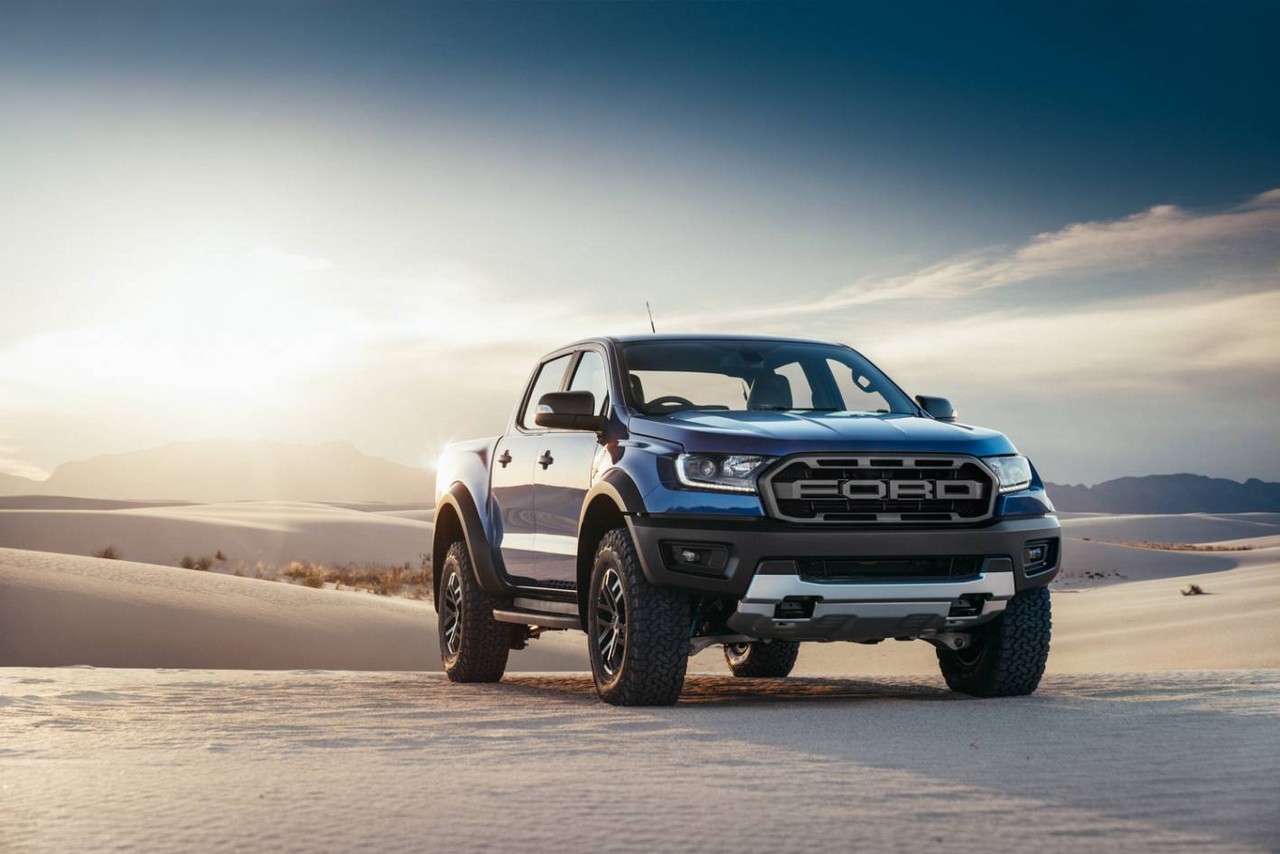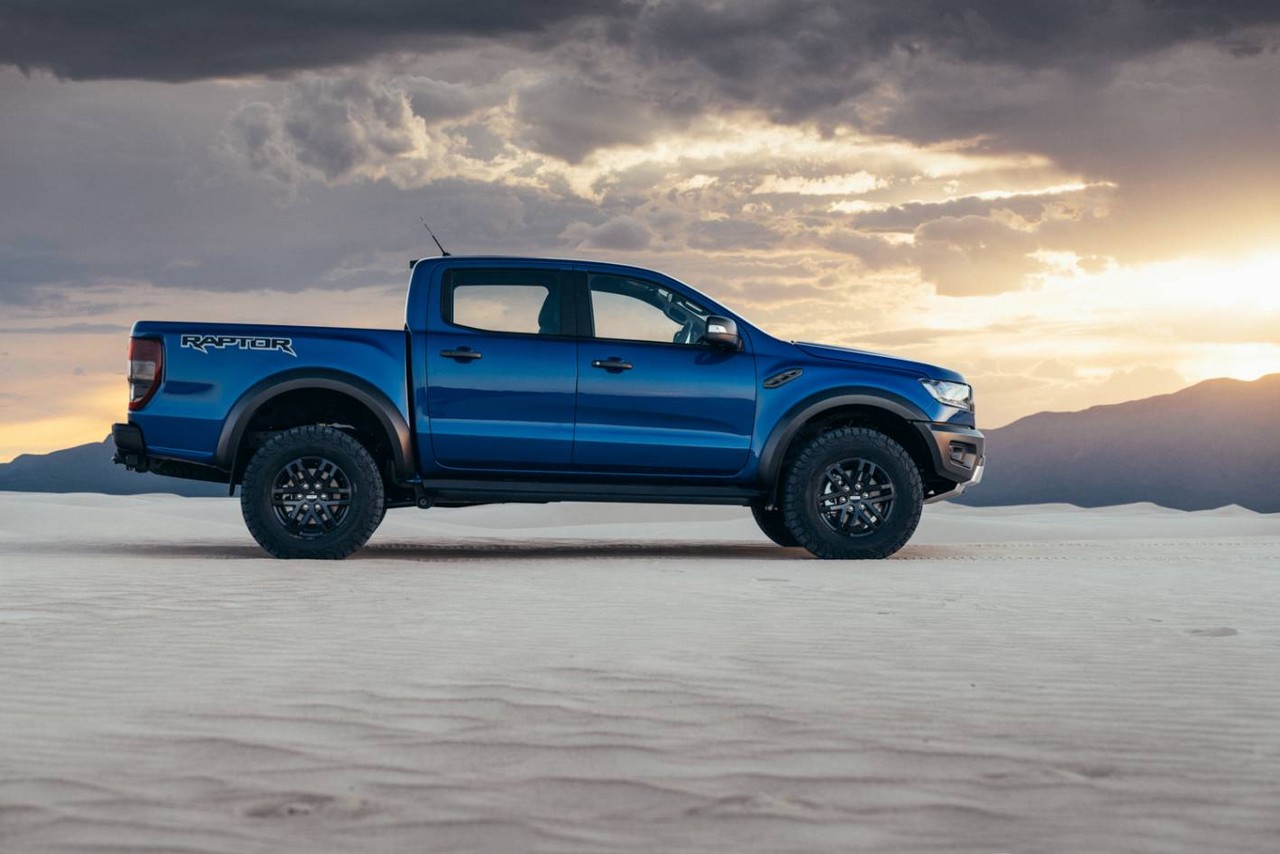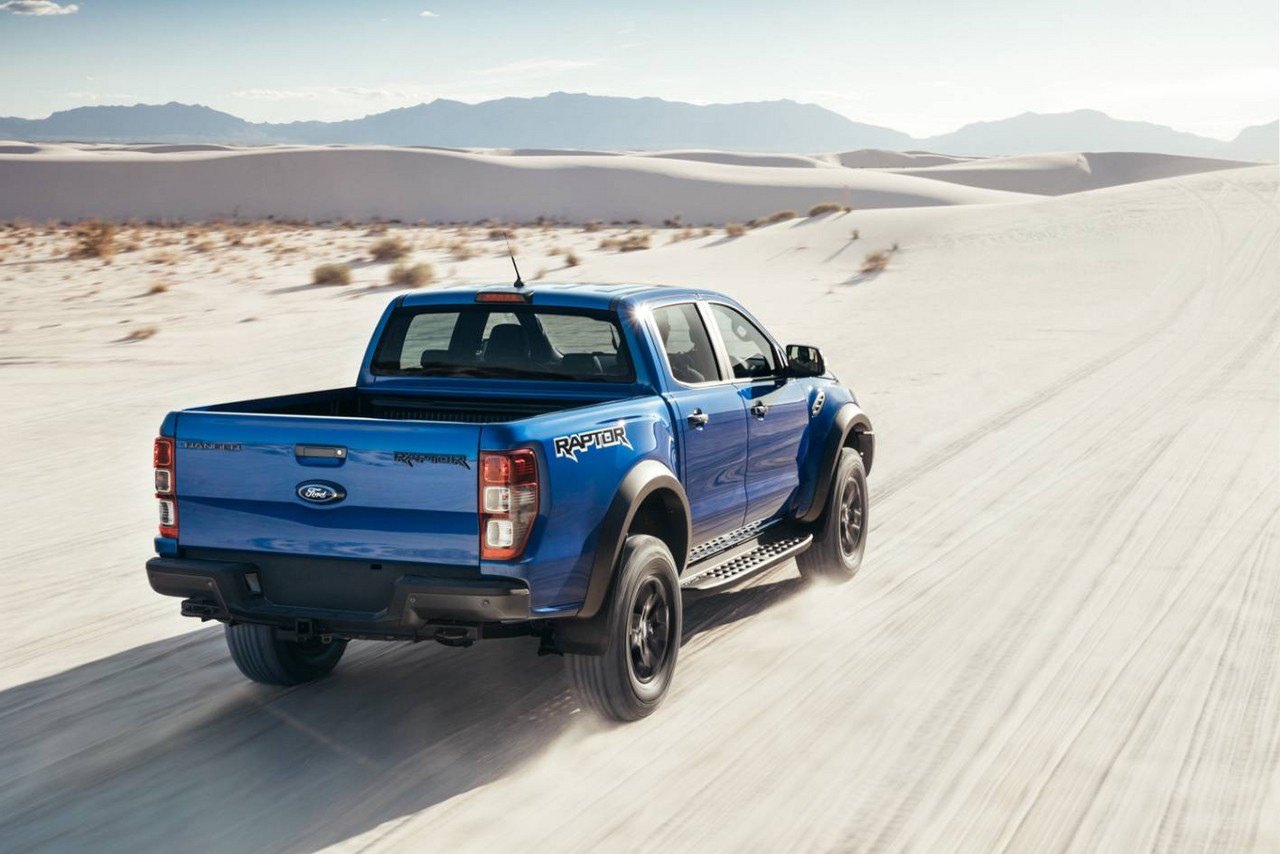
- Powerful 3.2-litre turbo-diesel engine
- Impressive ride/handling balance
- Supportive front seats
- High braked towing capacity
- Manual transmission has notchy action and high clutch take-up
- Steering wheel lacks reach adjustment
- Front seats lack lateral support
- Cargo bay doesn’t fit a full-size pallet
Review: Ford PX.I Ranger Pick-Up (2011-15)
Overview
Released in September 2011, the Ford PX Series I (PX.I) Ranger Pick-Up was available with a single, super or double cab body. The range initially consisted of double cab models powered by 3.2-litre five-cylinder turbo-diesel engines, but was subsequently expanded in late 2011 and the Wildtrak variants followed in June 2012. In addition to rear- and four-wheel drive models, the turbo-diesel rear-wheel drive models were sold as Hi-Rider editions (‘HR’ in the table below), which had the same ride height and ground clearance as the four-wheel drive models. A mid-range XLS variant was introduced in April 2013, while a fleet-focused XL Plus followed in April 2014.
Like the PK Ranger utility , the PX Ranger had a ladder frame chassis, but its body was twice as stiff. Furthermore, a rack and pinion steering system was introduced (previously a recirculating ball arrangement) and refinement was improved with the introduction of special fluid-filled cab mounts to the frame. The PX Ranger’s front suspension consisted of double A-arms with upper and lower ball joints at the front, with leaf springs at the rear.
| Cab | Engine | Variant | Drive | Trans. | Peak power | Peak torque |
|---|---|---|---|---|---|---|
| Single | 2.2-litre turbo-diesel I4 | XL | RWD | 6sp man. | 110 kW at 3700 rpm | 375 Nm at 1500-2500 rpm |
| Super | 3.2-litre turbo-diesel I5 | XLT | RWD (HR) | 6sp auto | 147 kW at 3000 rpm | 470 Nm at 1500-2750 rpm |
| XL | 4WD | 6sp auto | ||||
| XLT | 4WD | 6sp man., 6sp auto |
||||
| Double | 2.5-litre petrol I4 | XL | RWD | 5sp man. | 122 kW at 6000 rpm | 226 Nm at 4500 rpm |
| 2.2-litre turbo-diesel I4 | XL | RWD (HR), 4WD |
6sp man., 6sp auto |
110 kW at 3700 rpm | 375 Nm at 1500-2500 rpm | |
| XLS | 4WD | 6sp man., 6sp auto |
110 kW at 3700 rpm | 375 Nm at 1500-2500 rpm | ||
| 3.2-litre turbo-diesel I5 | XL Plus | 4WD | 6sp auto | 147 kW at 3000 rpm | 470 Nm at 1500-2750 rpm | |
| XLT | RWD (HR) | 6sp man., 6sp auto |
||||
| XL, XLS, XLT, Wildtrak |
4WD | 6sp man., 6sp auto |
| XL Single Cab RWD | XL Super Cab 4WD | XLT Super Cab RWD (HR)/4WD | XL Dual Cab RWD | XL Dual Cab 4WD (HR)/4WD | XLT Dual Cab RWD (HR)/4WD | Wild-track Dual Cab 4WD | |
|---|---|---|---|---|---|---|---|
| Height (mm) | 1703 | 1804 | 1810 | 1716 | 1815 | 1821 | 1848 |
| Width (mm) | 1850 | 1850 | 1850 | 1850 | 1850 | 1850 | 1850 |
| Length (mm) | 5359 | 5359 | 5351 | 5359 | 5359 | 5351 | 5351 |
| Wheelbase (mm) | 3220 | 3220 | 3220 | 3220 | 3220 | 3220 | 3220 |
| Ground clearance (unladen, mm) | 201 | 232 | 237 | 201 | 232 | 237 | 237 |
| Wading depth (mm) | 600 | 800 | 800 | 600 | 800 | 800 | 800 |
| Approach angle (unladen, degrees) | 22° | 28° | 29° | 22° | 28° | 29° | 29° |
| Pick-up Box dimensions (mm) | |||||||
| Length – at floor | 2317 | 1847 | 1847 | 1549 | 1549 | 1549 | 1549 |
| Length – top of box | 2253 | 1783 | 1783 | 1485 | 1485 | 1485 | 1485 |
| Width – pick-up box | 1560 | 1560 | 1560 | 1560 | 1560 | 1560 | 1560 |
| Width – between wheelarches | 1139 | 1139 | 1139 | 1139 | 1139 | 1139 | 1139 |
| Height – at axle centreline | 511 | 511 | 511 | 511 | 511 | 511 | 511 |
| Width of rear opening | 1330 | 1330 | 1330 | 1330 | 1330 | 1330 | 1330 |
| Height – floor height to ground | 723 | 835 | 840 | 723 | 835 | 840 | 840 |
4WD system
The four-wheel drive Ford Ranger models had an electronic ‘shift on the fly feature’ which enabled the driver to switch between high-range rear-wheel drive, high-range four-wheel drive and low-range four-wheel drive via a switch on the centre console. Furthermore, all four-wheel drive XL Plus, XLS, XLT and Wildtrak variants were also fitted with an electronic rear differential lock.
Safety equipment
Standard safety equipment for the Ford PX.I Ranger included dual front airbags, electronic stability control with roll-over mitigation, trailer sway control, traction control, ABS, electronic brake force distribution, brake assist and hill start assist. The XL Hi-Rider, XLS, XLT and Wildtrak variants were further equipped with front seat-mounted side airbags and front curtain airbags (i.e. no rear curtain airbags for double cab models).
From 2014, front seat-mounted side airbags and front curtain airbags were fitted as standard.
Euro NCAP testing
In Euro NCAP testing , the Ford Ranger Pick-up double cab was awarded a five star safety rating, when fitted with front side airbags and curtain airbags, including a 96 per cent adult occupant protection score and an 86 per cent child occupant protection score. Under ANCAP’s methodology, this testing resulted in a five star adult occupant protection rating with a score of 35.72 out of 37.
Features: Ranger XL, XLS, XLT and Wildtrak
Standard features for the Ford Ranger XL included 16-inch steel wheels, a four speaker sound system with auxiliary inputs (3.5mm/USB/iPod) and MP3-compatibility, air conditioning, a 4.2-inch multi-function colour display, cruise control, Bluetooth connectivity with voice control, automatic headlights, remote central locking, power windows and mirrors, a 12 volt power outlet and immobiliser. The Hi-Rider editions were further equipped with an alarm and ‘Hi-Rider’ decals, while double cab models also had a roll bar and tray bedliner with an integrated 12 volt power outlet.
The Ranger XLS was further equipped with 16-inch alloy wheels, front fog lights and carpeted floor coverings. Visually, the XLS could be identified by its silver-coloured grille and body-coloured door mirrors.
Beyond this, the Ranger XLT added 17-inch alloy wheels, dual-zone climate control air conditioning, a cooled centre console storage compartment, rear parking sensors, rain-sensing wipers, heated and power folding door mirrors, privacy glass, tow bar, side steps and an electrochromatic rear view mirror. From 2014, the XLT was also fitted with a satellite navigation system which had a five-inch colour display.
The range-topping Ranger Wildtrak was distinguished by its 18-inch alloy wheels, satellite navigation with five-inch multi-function colour display, combination leather and fabric upholstery, eight-way power adjustable front seats and roof rails.
2014 Ranger 4×4 XL Plus
In 2014, the Ford Ranger XL Plus 4×4 double cab utility was released. Compared to the XL, the XL Plus featured 17-inch steel wheels with 265/65 R17 Continental all-terrain tyres and heavy duty canvas seat covers. The XL Plus also had an expanded wiring harness and switch bezel, a 75 ampere-hour front battery, a second 80 ampere-hour deep-cycle discharge Gel battery, a second battery isolator and a tow bar rated for 3500 kg.
Related links
Review: Ford PX.II Ranger Pick-Up (2015-18)
Overview
Released in Australia in July 2015, the Ford PX Series II (PX.II) Ranger introduced an updated interior, mechanical upgrades and greater refinement. For models with manual transmissions, the 2.2- and 3.2-litre turbo-diesel engines had an ‘Auto Stop/Start’ function which enabled them to shut down when the vehicle was stationary in traffic to minimise fuel consumption. Furthermore, the 3.2-litre turbo-diesel engine had an updated exhaust gas recirculation system, while the 2.2-litre turbo-diesel engine benefited from greater torque.
Other changes for the Ford PX.II Ranger included the introduction of electric power-assisted steering – which varied power assistance according to vehicle speed, steering wheel angle and cornering forces – and revised suspension for improved ride comfort. For greater refinement, the PX.II Ranger had enhanced sound insulation.
Visually, the PX.II Ranger could be identified by its more ‘muscular’ bonnet, trapezoidal grille and ‘imposing’ headlights, styling themes which were shared with the Ford Everest SUV. Inside, the PX.II Ranger XLT and Wildtrak were fitted with an eight-inch touchscreen and dual TFT instrument cluster which was capable of displaying navigation information and climate control settings.
| Cab | Engine | Variant | Drive | Trans. | Peak power | Peak torque |
|---|---|---|---|---|---|---|
| Single | 2.2-litre turbo-diesel I4 | XL | RWD | 6sp man. | 118 kW at 3200 rpm | 385 Nm at 1600-2500 rpm |
| Super | 3.2-litre turbo-diesel I5 | XLT | RWD (HR) | 6sp auto | 147 kW at 3000 rpm | 470 Nm at 1750-2500 rpm |
| XL | 4WD | 6sp auto | ||||
| XLT | 4WD | 6sp man., 6sp auto |
||||
| Double | 2.2-litre turbo-diesel I4 | XL | RWD (HR), 4WD |
6sp man., 6sp auto |
118 kW at 3200 rpm | 385 Nm at 1600-2500 rpm |
| XLS | 4WD | 6sp man., 6sp auto |
118 kW at 3200 rpm | 385 Nm at 1600-2500 rpm | ||
| 3.2-litre turbo-diesel I5 | XL Plus | 4WD | 6sp auto | 147 kW at 3000 rpm | 470 Nm at 1750-2500 rpm | |
| XLT | RWD (HR) | 6sp man., 6sp auto |
||||
| XL, XLS, XLT, Wildtrak |
4WD | 6sp man., 6sp auto |
Safety equipment
For the Ford PX.II Ranger, standard safety equipment included dual front airbags, front seat-mounted side airbags, front curtain airbags, ABS, electronic brake force distribution, brake assist, electronic stability control, traction control and front seatbelts with pre-tensioners and load limiters.
As standard, the Ford PX.II Ranger was fitted with Ford’s ‘SYNC’ connectivity system ‘Emergency Assistance’ which, in the event of an accident in which the airbags deployed or the fuel cut-off switch was activated, could deliver a voice message to 000 operators and keep the line open for hands-free communication.
From June 2016, the Ford Ranger Wildtrak was equipped with:
- Forward Collision Warning;
- Driver Impairment Monitor;
- Lane Departure Warning; and,
- Lane Keeping Aid.
For information on these safety technologies, please refer to ‘Tech Pack: Ranger XLT and Wildtrak’, below.
Tech Pack: Ranger XLT and Wildtrak
Upon its release, the Ford Ranger XLT and Wildtrak could be specified with an optional ‘Tech Pack’ which included –
- Adaptive Cruise Control: adaptive cruise control could adjust vehicle speed to maintain a pre-set distance from the vehicle ahead by braking or accelerating up to the specified cruising speed;
- Forward Collision Warning: in the event that the distance to the vehicle ahead decreased such that there was a risk of collision, the driver would be alerted by a heads-up display on the windscreen and the braking system would be primed for maximum braking assistance;
- Lane Departure Warning: if the forward-facing camera detected that the Ford Ranger was about to depart from its lane without indicating, the driver would be alerted via steering wheel vibrations;
- Lane Keeping Aid: if the Ranger departed from its lane, steering torque would be applied to return the vehicle to its lane;
- Driver Impairment Monitor: monitored driver behaviour for signs of fatigue and, if detected, would alert the driver; and,
- A reverse camera (standard on Wildtrak).
Features: Ford PX.II Ranger
Standard features for the Ford PX.II Ranger XL included 16 x 6.5J steel wheels with 215/70 R16 tyres, a four speaker sound system with auxiliary inputs (3.5 mm/USB) and iPod integration, Bluetooth mobile phone connectivity with voice control, ‘Circuit Fabric in Ebony’ seat trim with ‘Pulse Fabric in Ebony’ bolsters, air conditioning, cruise control with adjustable speed limiter, automatic headlights, remote central locking, power windows and mirrors, a 230 volt power inverter, a 12 volt power socket and an immobiliser.
Compared to the Ranger XL, the XL Plus added 17-inch steel wheels, daytime running lights, plastic side steps, a tow bar and a second battery.
Relative to the Ranger XL, the Ranger XLS added 16-inch alloy wheels, front fog lights, carpeted floors and a driver’s side floor mat.
The Ranger XLT was further equipped with 17 x 8.0J alloy wheels with 265/65 R17 tyres, Ford’s ‘SYNC 2’ connectivity system, voice-controlled satellite navigation with an eight-inch touch screen, digital radio tuner (DAB), mobile Wi-Fi hotspot, ‘Penta Fabric in Ebony’ seat trim with ‘Catalyst Fabric in Ebony’ bolsters, dual-zone climate control air conditioning, projector headlights, rear parking sensors, rain-sensing wipers, heated door mirrors, an electrochromatic rear view mirror, illuminated vanity mirrors, colour 4.2-inch TFT displays in the instrument cluster, rear privacy glass, tyre pressure monitoring, bedliner with 12 volt power socket, plastic side steps and a tow bar.
The range-topping Ford Ranger Wildtrak was distinguished by its 18 x 8.0J alloy wheels with 265/60 R18 tyres, ‘Caliber Fabric in Trak Orange’ seat trim with ‘Journey Grain Leather in Ebony’ bolsters, heated front seats, rear view camera, front parking sensors, roof rails, roller shutter, puddle lamps and ambient lighting.
June 2016 update
From June 2016, all Ford PX Ranger Pick-Up models – except the XL Plus variant – were fitted with a rear view camera and rear parking sensors. Furthermore,
- The Ranger XLS gained a second key fob;
- The Ranger XLT was fitted with front parking sensors and could be identified by its black fog lamp bezels;
- The Ranger XLT and Wildtrak were equipped with Ford’s ‘SYNC 3’ connectivity system which had an eight-inch touchscreen, a more powerful processor, ‘more conversational’ voice recognition and an improved graphic user interface (GUI). The SYNC 3 system also featured Apple CarPlay and Android Auto integration, while compatible apps included Spotify, Pandora and Google Maps+; and,
- The Ranger Wildtrak was equipped with automatic high beam control.
2017 Ford Ranger FX4 Double Cab
The Ford Ranger FX4 Double Cab was released in Australia in February 2017. Based on the Ranger XLT and powered by the 3.2-litre turbo-diesel engine, the Ranger FX4 could be identified by its 18-inch ‘Stark Grey’ alloy wheels, black bonnet and tailgate decal wraps, a black grille, fog lamp bezels, door mirrors, roof rails, side steps, door handles, sports bar and rear bumper. Inside, the Ford Ranger FX4 featured leather accented seats with ‘FX4’ branding and carpet mats (front and rear).
June 2017 update
In June 2017, the following revisions were introduced for the Ford PX.II Ranger –
- The external temperature display (with frost/ice warning) was made standard for all variants other than the XL Plus – it had previously been limited to the XLT and Wildtrak variants;
- For all variants, ‘secure fingers’ were added to the cup holders to better secure bottles and cups;
- For the Ranger XLS, the outer tie down hooks were removed for a ‘sleeker appearance’;
- For the Ranger XLT double cab, buyers could specify leather seats and door trim inserts as a $1650 option; and,
- For the Ranger Wildtrak, new seat fabrics were introduced which were more resistant to staining and soiling. The seats also had less piping and a shorter front cushion overhang to improve comfort.
Brochure
Review: Ford PX.III Ranger Pick-Up (2018-22)
Overview
Released in Australia in September 2018, the Ford PX Series III (PX.III) Ranger introduced updated styling, biturbo diesel engines and a new Raptor variant.
Available for the Ranger XLT, Wildtrak and Raptor, the 2.0-litre diesel engine had sequential turbocharging whereby a fixed-geometry turbocharger operates spooled up quickly at low engine speeds and a variable geometry turbocharger took over from the fixed-geometry turbocharger at higher engine speeds. The 2.0-litre biturbo diesel engine was mated to a ten-speed automatic transmission.
Visually, the Ford PX.III Ranger could be identified by its ‘cleaner’ new grille with distinctive ‘nostrils’ and ‘more distinctively chiselled’ lower bumper with a wider air intake. The PX.III Ranger Wildtrak and XLT also had daytime LED running lights and high intensity discharge (HID) headlights. All PX.III Ranger Pick-Up models were fitted with an ‘easy-lift’ tailgate which had a new internal mechanism that reduced the initial force required to lift the tailgate by 70 per cent.
Inside, the Ford PX.III Ranger had a black theme which was complemented by shadow chrome elements and silver accent stitching.
| Cab | Engine | Variant | Drive | Trans. | Peak power | Peak torque |
|---|---|---|---|---|---|---|
| Single | 2.2-litre turbo-diesel I4 | XL | RWD | 6sp man. | 118 kW at 3200 rpm | 385 Nm at 1600-2500 rpm |
| Super | 3.2-litre turbo-diesel I5 | XLT | RWD (HR) | 6sp auto | 147 kW at 3000 rpm | 470 Nm at 1750-2500 rpm |
| XL | 4WD | 6sp auto | ||||
| XLT | 4WD | 6sp man., 6sp auto |
||||
| Double | 2.2-litre turbo-diesel I4 | XL | RWD (HR), 4WD |
6sp man., 6sp auto |
118 kW at 3200 rpm | 385 Nm at 1600-2500 rpm |
| XLS | 4WD | 6sp man., 6sp auto |
118 kW at 3200 rpm | 385 Nm at 1600-2500 rpm | ||
| 3.2-litre turbo-diesel I5 | XLT | RWD (HR) |
6sp man., 6sp auto |
147 kW at 3000 rpm | 470 Nm at 1750-2500 rpm | |
| XL, XLS, XLT, Wildtrak |
4WD | 6sp man., 6sp auto |
||||
| 2.0-litre biturbo diesel I4 | XLT, Wildtrak, Raptor |
4WD | 10sp auto | 157 kW at 3750 rpm | 500 Nm at 1750-2000 rpm |
Suspension
The Ford PX.III Ranger introduced revised suspension geometry to improve ride quality, body roll (particularly when fully-laden or towing) and steering precision.
Safety equipment
For the Ford PX.III Ranger Wildtrak, standard safety equipment was extended to include:
- Inter-Urban Autonomous Emergency Braking (AEB) with Vehicle Detection and Pedestrian Detection: operates at speeds above 3.6 km/h, the system can detect objects in front of the vehicle and warn the driver if there is a risk of collision. If a collision is assessed to be imminent, autonomous emergency braking is initiated to reduce vehicle speed;
- Adaptive Cruise Control with Forward Collision Warning;
- Lane Departure Warning;
- Lane Keeping Aid; and,
- Traffic Sign Recognition: can identify traffic signs and display the detected speed limit in the instrument cluster;
These safety technologies were available as extra-cost options for the Ford PX.III Ranger XLT.
From March 2019, the Ford Ranger was equipped – as standard – with:
- Inter-Urban Autonomous Emergency Braking with Vehicle Detection and Pedestrian Detection;
- Lane Keep Assist/Lane Departure Warning;
- Traffic Sign Recognition; and,
- Auto High Beam.
Features: Ford PX.III Ranger
For the Ford PX.III Ranger, standard features were extended to include rear parking sensors and the easy-lift tailgate (described above). Beyond this, the Ranger XLS gained front parking sensors.
For the Ford PX.III Ranger XLT and Wildtrak, standard features were extended to include high intensity discharge (HID) headlights, LED daytime running lights and Ford’s ‘Passive Entry Passive Start’ (PEPS) (i.e. keyless entry and push-button start). As per the June 2016 update, the Ranger XLT and Wildtrak continued to be equipped with Ford’s ‘SYNC 3’ connectivity system which included an eight-inch colour touchscreen, satellite navigation, reversing camera and smartphone integration via Apple CarPlay and Android Auto. The satellite navigation system, however, gained a ‘breadcrumbs’ feature which allowed an unmarked off-road route to be mapped as it was traversed; complementary map updates were also available for up to seven years when a scheduled service was completed at a participating dealer.
As standard, the Ford Ranger Wildtrak was equipped with LED front fog lamps, a power lock tailgate and ‘Active Park Assist’ (APA) which could automatically steer the vehicle into parallel parking spaces while the driver controlled vehicle speed.
Ford Ranger Raptor
The Ford Ranger Raptor was a dual-cab utility designed by Ford Performance team for the ‘true enthusiast off-roader’. The Ford Ranger Raptor is powered by a 2.0-litre diesel engine that had two water-cooled turbochargers: the smaller, high-pressure turbocharger was connected in sequence to the larger, low-pressure turbocharger. Furthermore, the turbochargers were controlled with bypass valves that determined the operating mode based on engine speed. At low engine speeds, both turbochargers would work in series; at higher engine speeds, the small turbocharger was bypassed. The diesel engine was mated to a ten-speed automatic transmission and the Ford Ranger Raptor had a braked towing capacity of 2500 kg.
The Ford Ranger Raptor had ‘Fox Racing Shox’ shock absorbers (front and rear) which had 46.6 mm long pistons. Featuring an internal bypass, the ‘Position Sensitive Damping’ (PSD) shock absorbers provided higher damping forces at full jounce and rebound for improved off-road capability, and lower damping forces in the mid-travel range for improved on-road ride comfort. The suspension also provided an increased ride height (283 mm), a 32.5 degree approach angle, a 24 degree ramp over angle and a 24 degree departure angle. For the solid rear axle, changes for the Ranger Raptor included coilover springs and a Watt’s linkage to improve rear lateral stability.
For the Ford Ranger Raptor, the Terrain Management System (TMS) had six drive modes that could be selected via a five-button switch on the steering wheel –
- Normal;
- Sport: allowed higher engine speeds before gearshifts, provided faster gear shifts and more aggressive downshifts;
- Grass/Gravel/Snow: for slippery and uneven surfaces, this mode providesd slower gear shifts and second-gear starts;
- Mud/Sand: for deformable surfaces like loose sand and mud, this mode held lower gears for optimum traction;
- Rock: for low-speed rocky terrain; and,
- Baja: named after the Baja Desert Rally, this mode provided ‘high-speed off-road performance’.
As standard, the Ford Ranger Raptor was fitted with all-terrain BF Goodrich 285/70 R17 tyres. Beyond this, the Ranger Raptor had 332 mm by 32 mm ventilated front brake discs with twin-piston callipers and 332 mm by 24 mm ventilated rear discs.
Inside, the Ford Ranger Raptor featured unique front seats that had a ‘dual hardness cushion’ and were designed for ‘off-road high speed performance support’; the seats were also upholstered with ‘technical suede’ inserts. Beyond this, the Ranger Raptor had Ford’s ‘SYNC 3’ connectivity system, an eight-inch display, a satellite navigation system and a unique steering wheel with magnesium gearshift paddles and ‘on-centre’ marker.
Visually, the Ford Ranger Raptor could be identified by its:
- New front grille with black ‘FORD’ lettering;
- The front bumper with LED fog lamps and air-curtain ducts to reduce air resistance;
- Underbody ‘bash plate’ made from 2.3 mm thick high-strength steel;
A silver-finished front guard which provided clearance to the dual front recovery hooks (rated at 4.5 tonnes); - Flared front fenders to accommodate the wider track, larger tyres and long-travel suspension;
Die-cast aluminium alloy side steps; and, - Modified rear bumper with flush sensor bezels, an integrated tow bar and two recovery hooks rated at 3.8 tonnes.
The Ford Ranger Raptor was available in Lightning Blue, Race Red, Shadow Black, Frozen White and Conquer Grey paint finishes.
March 2019 update
From March 2019, the Ford Ranger XL and XLS variants were equipped with an ‘acoustic’ windscreen which reduced interior noise. The acoustic windscreen had previously been restricted to the Ranger XLT, Wildtrak and Raptor variants.
